Relationship between event and tourism
VerifiedAdded on 2022/08/12
|22
|5704
|32
AI Summary
Please let me know the cost for 4000 words
Contribute Materials
Your contribution can guide someone’s learning journey. Share your
documents today.
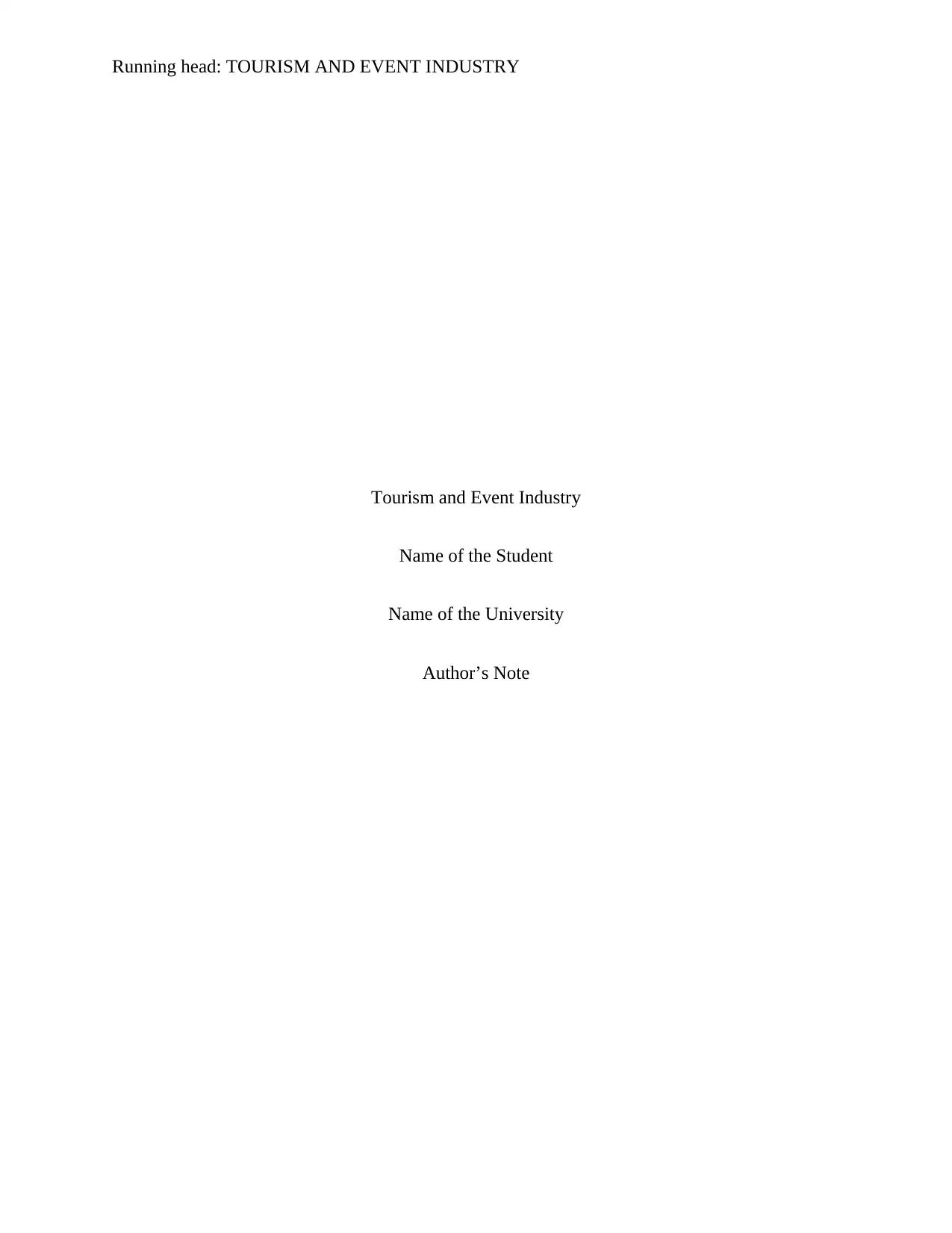
Running head: TOURISM AND EVENT INDUSTRY
Tourism and Event Industry
Name of the Student
Name of the University
Author’s Note
Tourism and Event Industry
Name of the Student
Name of the University
Author’s Note
Secure Best Marks with AI Grader
Need help grading? Try our AI Grader for instant feedback on your assignments.
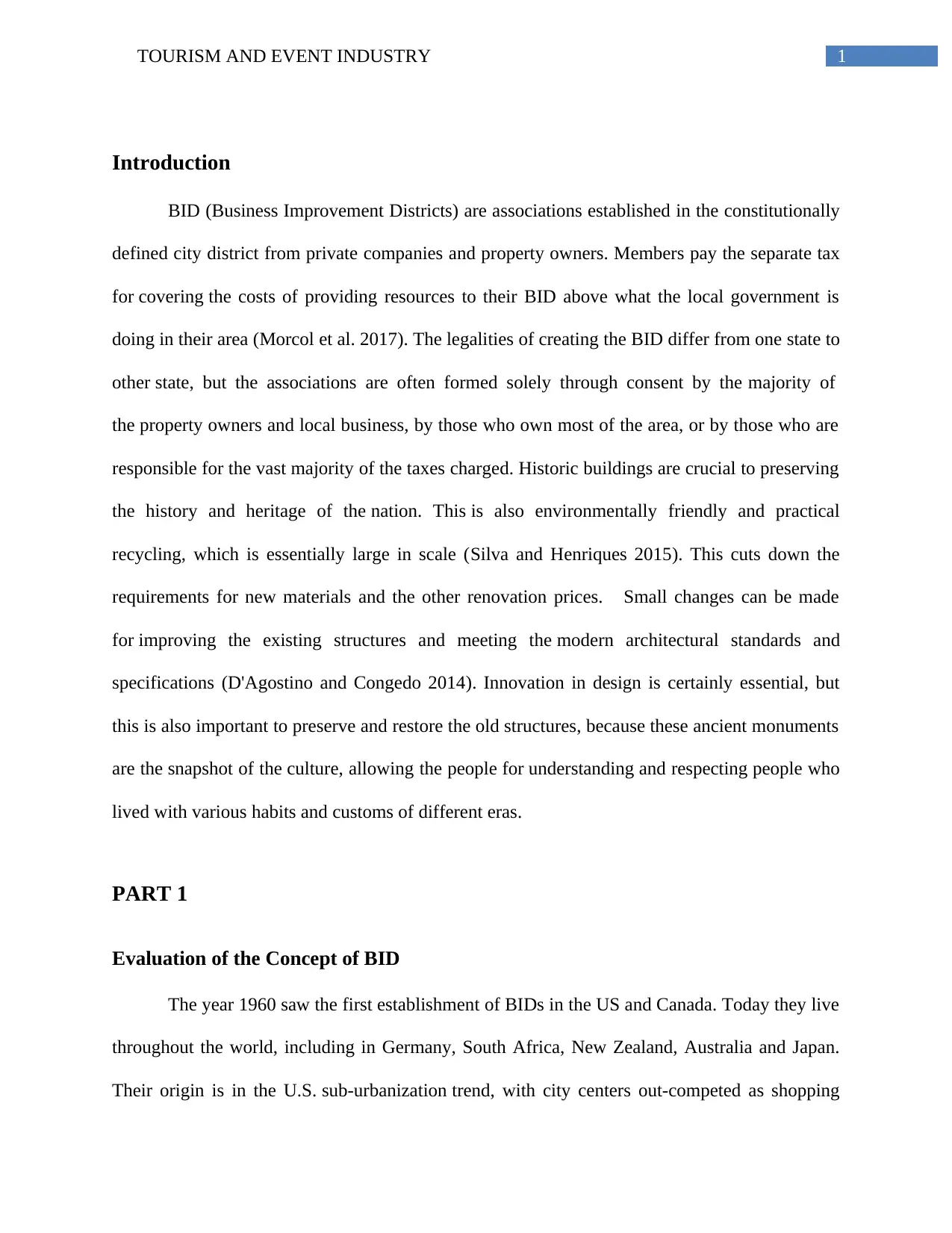
1TOURISM AND EVENT INDUSTRY
Introduction
BID (Business Improvement Districts) are associations established in the constitutionally
defined city district from private companies and property owners. Members pay the separate tax
for covering the costs of providing resources to their BID above what the local government is
doing in their area (Morcol et al. 2017). The legalities of creating the BID differ from one state to
other state, but the associations are often formed solely through consent by the majority of
the property owners and local business, by those who own most of the area, or by those who are
responsible for the vast majority of the taxes charged. Historic buildings are crucial to preserving
the history and heritage of the nation. This is also environmentally friendly and practical
recycling, which is essentially large in scale (Silva and Henriques 2015). This cuts down the
requirements for new materials and the other renovation prices. Small changes can be made
for improving the existing structures and meeting the modern architectural standards and
specifications (D'Agostino and Congedo 2014). Innovation in design is certainly essential, but
this is also important to preserve and restore the old structures, because these ancient monuments
are the snapshot of the culture, allowing the people for understanding and respecting people who
lived with various habits and customs of different eras.
PART 1
Evaluation of the Concept of BID
The year 1960 saw the first establishment of BIDs in the US and Canada. Today they live
throughout the world, including in Germany, South Africa, New Zealand, Australia and Japan.
Their origin is in the U.S. sub-urbanization trend, with city centers out-competed as shopping
Introduction
BID (Business Improvement Districts) are associations established in the constitutionally
defined city district from private companies and property owners. Members pay the separate tax
for covering the costs of providing resources to their BID above what the local government is
doing in their area (Morcol et al. 2017). The legalities of creating the BID differ from one state to
other state, but the associations are often formed solely through consent by the majority of
the property owners and local business, by those who own most of the area, or by those who are
responsible for the vast majority of the taxes charged. Historic buildings are crucial to preserving
the history and heritage of the nation. This is also environmentally friendly and practical
recycling, which is essentially large in scale (Silva and Henriques 2015). This cuts down the
requirements for new materials and the other renovation prices. Small changes can be made
for improving the existing structures and meeting the modern architectural standards and
specifications (D'Agostino and Congedo 2014). Innovation in design is certainly essential, but
this is also important to preserve and restore the old structures, because these ancient monuments
are the snapshot of the culture, allowing the people for understanding and respecting people who
lived with various habits and customs of different eras.
PART 1
Evaluation of the Concept of BID
The year 1960 saw the first establishment of BIDs in the US and Canada. Today they live
throughout the world, including in Germany, South Africa, New Zealand, Australia and Japan.
Their origin is in the U.S. sub-urbanization trend, with city centers out-competed as shopping
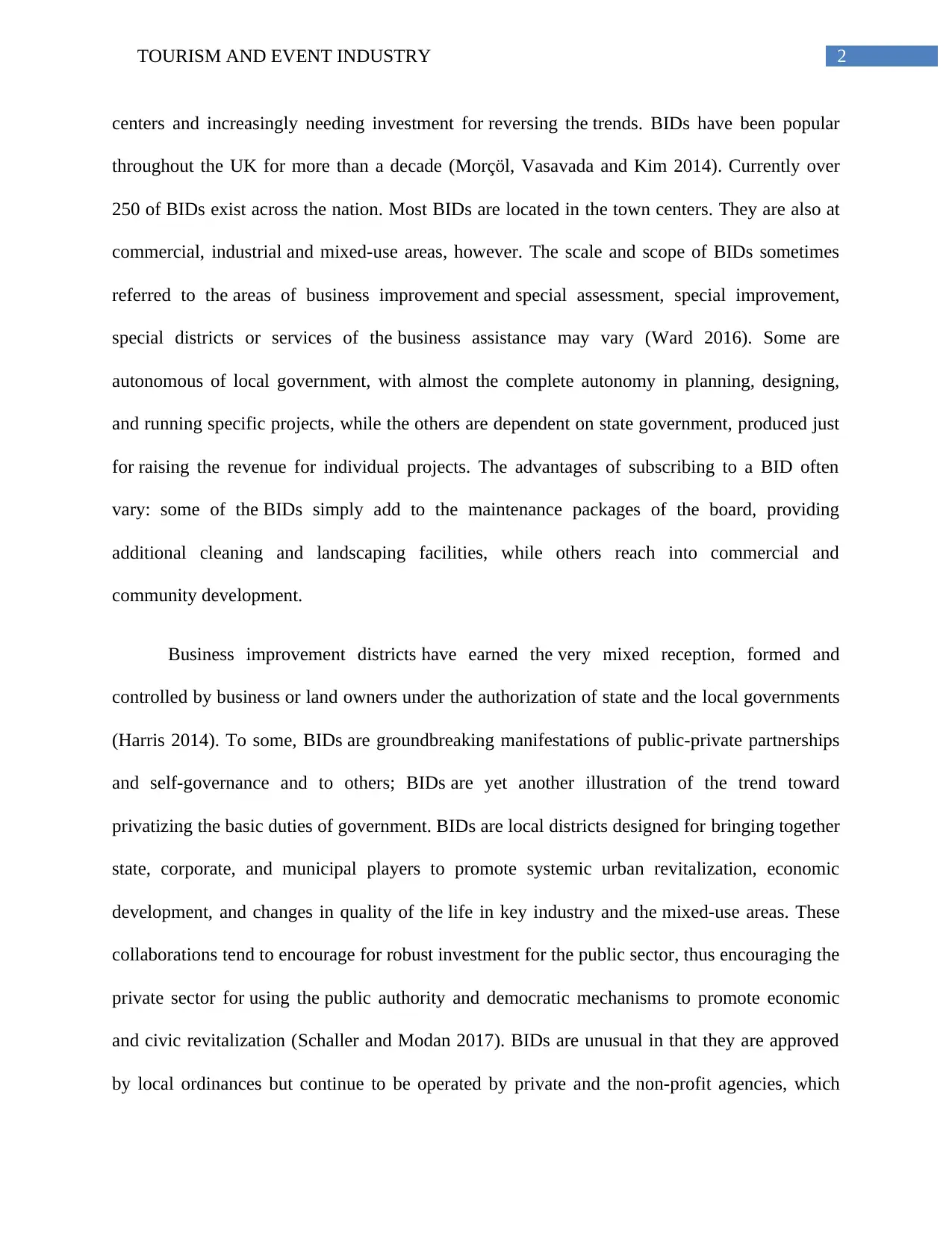
2TOURISM AND EVENT INDUSTRY
centers and increasingly needing investment for reversing the trends. BIDs have been popular
throughout the UK for more than a decade (Morçöl, Vasavada and Kim 2014). Currently over
250 of BIDs exist across the nation. Most BIDs are located in the town centers. They are also at
commercial, industrial and mixed-use areas, however. The scale and scope of BIDs sometimes
referred to the areas of business improvement and special assessment, special improvement,
special districts or services of the business assistance may vary (Ward 2016). Some are
autonomous of local government, with almost the complete autonomy in planning, designing,
and running specific projects, while the others are dependent on state government, produced just
for raising the revenue for individual projects. The advantages of subscribing to a BID often
vary: some of the BIDs simply add to the maintenance packages of the board, providing
additional cleaning and landscaping facilities, while others reach into commercial and
community development.
Business improvement districts have earned the very mixed reception, formed and
controlled by business or land owners under the authorization of state and the local governments
(Harris 2014). To some, BIDs are groundbreaking manifestations of public-private partnerships
and self-governance and to others; BIDs are yet another illustration of the trend toward
privatizing the basic duties of government. BIDs are local districts designed for bringing together
state, corporate, and municipal players to promote systemic urban revitalization, economic
development, and changes in quality of the life in key industry and the mixed-use areas. These
collaborations tend to encourage for robust investment for the public sector, thus encouraging the
private sector for using the public authority and democratic mechanisms to promote economic
and civic revitalization (Schaller and Modan 2017). BIDs are unusual in that they are approved
by local ordinances but continue to be operated by private and the non-profit agencies, which
centers and increasingly needing investment for reversing the trends. BIDs have been popular
throughout the UK for more than a decade (Morçöl, Vasavada and Kim 2014). Currently over
250 of BIDs exist across the nation. Most BIDs are located in the town centers. They are also at
commercial, industrial and mixed-use areas, however. The scale and scope of BIDs sometimes
referred to the areas of business improvement and special assessment, special improvement,
special districts or services of the business assistance may vary (Ward 2016). Some are
autonomous of local government, with almost the complete autonomy in planning, designing,
and running specific projects, while the others are dependent on state government, produced just
for raising the revenue for individual projects. The advantages of subscribing to a BID often
vary: some of the BIDs simply add to the maintenance packages of the board, providing
additional cleaning and landscaping facilities, while others reach into commercial and
community development.
Business improvement districts have earned the very mixed reception, formed and
controlled by business or land owners under the authorization of state and the local governments
(Harris 2014). To some, BIDs are groundbreaking manifestations of public-private partnerships
and self-governance and to others; BIDs are yet another illustration of the trend toward
privatizing the basic duties of government. BIDs are local districts designed for bringing together
state, corporate, and municipal players to promote systemic urban revitalization, economic
development, and changes in quality of the life in key industry and the mixed-use areas. These
collaborations tend to encourage for robust investment for the public sector, thus encouraging the
private sector for using the public authority and democratic mechanisms to promote economic
and civic revitalization (Schaller and Modan 2017). BIDs are unusual in that they are approved
by local ordinances but continue to be operated by private and the non-profit agencies, which
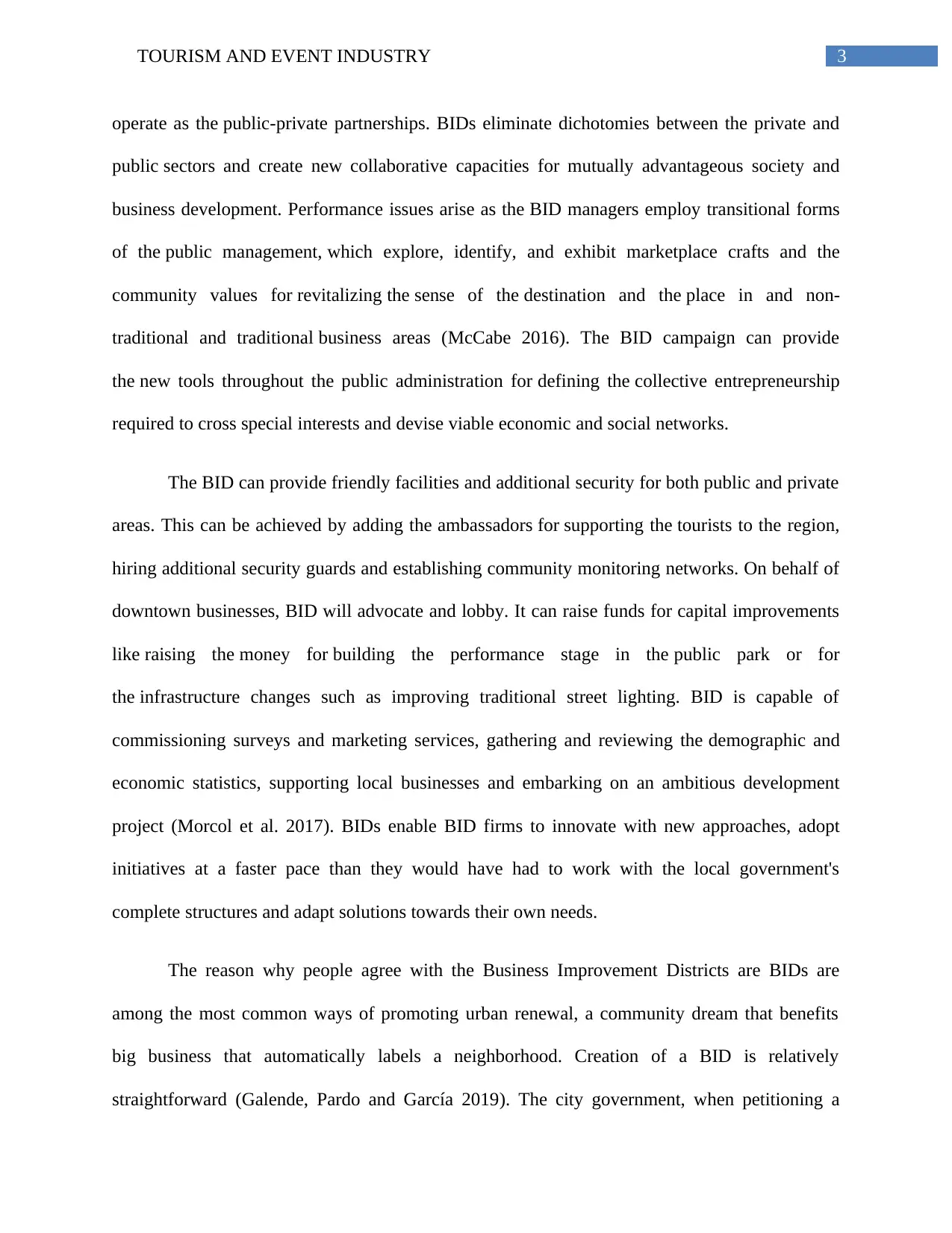
3TOURISM AND EVENT INDUSTRY
operate as the public-private partnerships. BIDs eliminate dichotomies between the private and
public sectors and create new collaborative capacities for mutually advantageous society and
business development. Performance issues arise as the BID managers employ transitional forms
of the public management, which explore, identify, and exhibit marketplace crafts and the
community values for revitalizing the sense of the destination and the place in and non-
traditional and traditional business areas (McCabe 2016). The BID campaign can provide
the new tools throughout the public administration for defining the collective entrepreneurship
required to cross special interests and devise viable economic and social networks.
The BID can provide friendly facilities and additional security for both public and private
areas. This can be achieved by adding the ambassadors for supporting the tourists to the region,
hiring additional security guards and establishing community monitoring networks. On behalf of
downtown businesses, BID will advocate and lobby. It can raise funds for capital improvements
like raising the money for building the performance stage in the public park or for
the infrastructure changes such as improving traditional street lighting. BID is capable of
commissioning surveys and marketing services, gathering and reviewing the demographic and
economic statistics, supporting local businesses and embarking on an ambitious development
project (Morcol et al. 2017). BIDs enable BID firms to innovate with new approaches, adopt
initiatives at a faster pace than they would have had to work with the local government's
complete structures and adapt solutions towards their own needs.
The reason why people agree with the Business Improvement Districts are BIDs are
among the most common ways of promoting urban renewal, a community dream that benefits
big business that automatically labels a neighborhood. Creation of a BID is relatively
straightforward (Galende, Pardo and García 2019). The city government, when petitioning a
operate as the public-private partnerships. BIDs eliminate dichotomies between the private and
public sectors and create new collaborative capacities for mutually advantageous society and
business development. Performance issues arise as the BID managers employ transitional forms
of the public management, which explore, identify, and exhibit marketplace crafts and the
community values for revitalizing the sense of the destination and the place in and non-
traditional and traditional business areas (McCabe 2016). The BID campaign can provide
the new tools throughout the public administration for defining the collective entrepreneurship
required to cross special interests and devise viable economic and social networks.
The BID can provide friendly facilities and additional security for both public and private
areas. This can be achieved by adding the ambassadors for supporting the tourists to the region,
hiring additional security guards and establishing community monitoring networks. On behalf of
downtown businesses, BID will advocate and lobby. It can raise funds for capital improvements
like raising the money for building the performance stage in the public park or for
the infrastructure changes such as improving traditional street lighting. BID is capable of
commissioning surveys and marketing services, gathering and reviewing the demographic and
economic statistics, supporting local businesses and embarking on an ambitious development
project (Morcol et al. 2017). BIDs enable BID firms to innovate with new approaches, adopt
initiatives at a faster pace than they would have had to work with the local government's
complete structures and adapt solutions towards their own needs.
The reason why people agree with the Business Improvement Districts are BIDs are
among the most common ways of promoting urban renewal, a community dream that benefits
big business that automatically labels a neighborhood. Creation of a BID is relatively
straightforward (Galende, Pardo and García 2019). The city government, when petitioning a
Secure Best Marks with AI Grader
Need help grading? Try our AI Grader for instant feedback on your assignments.
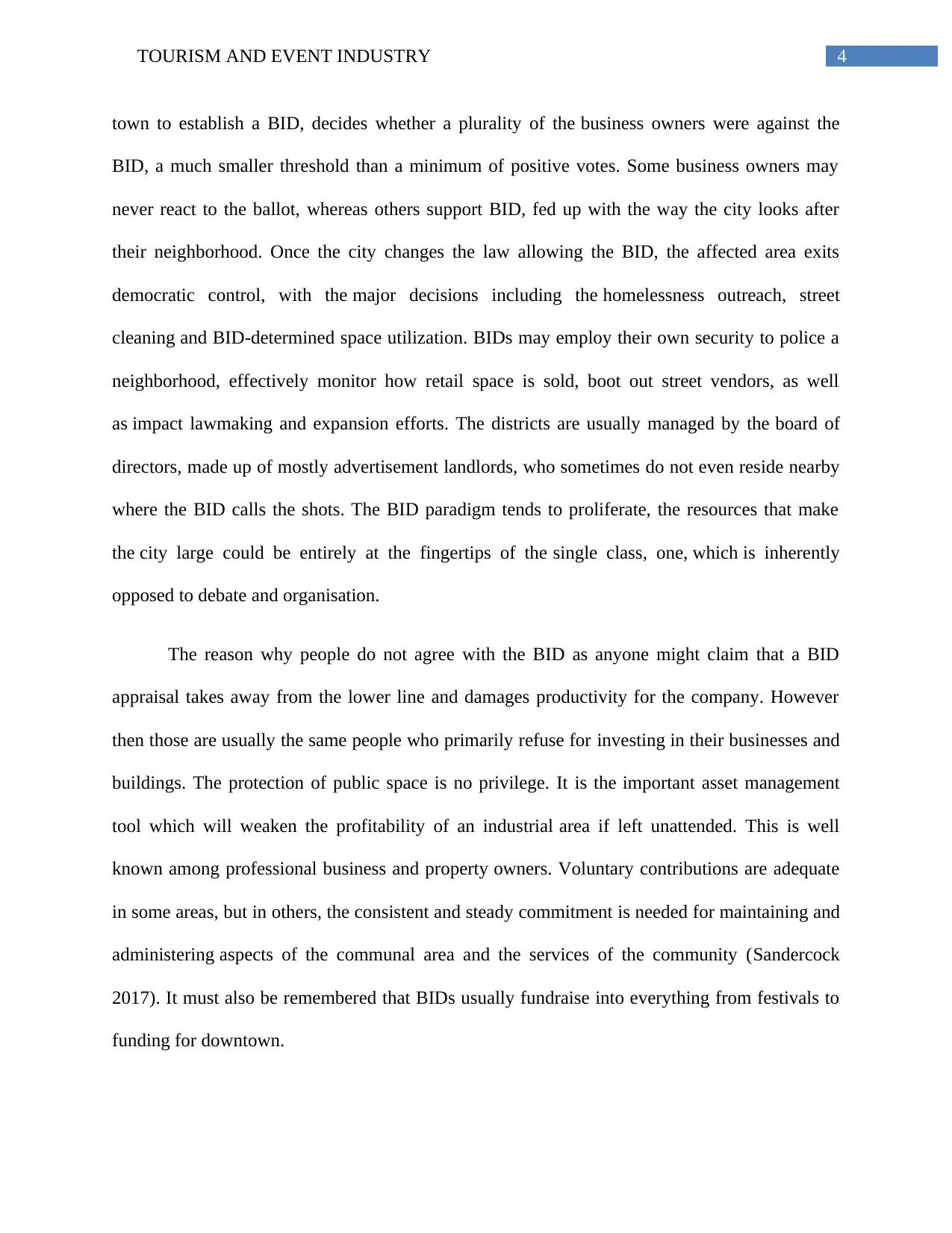
4TOURISM AND EVENT INDUSTRY
town to establish a BID, decides whether a plurality of the business owners were against the
BID, a much smaller threshold than a minimum of positive votes. Some business owners may
never react to the ballot, whereas others support BID, fed up with the way the city looks after
their neighborhood. Once the city changes the law allowing the BID, the affected area exits
democratic control, with the major decisions including the homelessness outreach, street
cleaning and BID-determined space utilization. BIDs may employ their own security to police a
neighborhood, effectively monitor how retail space is sold, boot out street vendors, as well
as impact lawmaking and expansion efforts. The districts are usually managed by the board of
directors, made up of mostly advertisement landlords, who sometimes do not even reside nearby
where the BID calls the shots. The BID paradigm tends to proliferate, the resources that make
the city large could be entirely at the fingertips of the single class, one, which is inherently
opposed to debate and organisation.
The reason why people do not agree with the BID as anyone might claim that a BID
appraisal takes away from the lower line and damages productivity for the company. However
then those are usually the same people who primarily refuse for investing in their businesses and
buildings. The protection of public space is no privilege. It is the important asset management
tool which will weaken the profitability of an industrial area if left unattended. This is well
known among professional business and property owners. Voluntary contributions are adequate
in some areas, but in others, the consistent and steady commitment is needed for maintaining and
administering aspects of the communal area and the services of the community (Sandercock
2017). It must also be remembered that BIDs usually fundraise into everything from festivals to
funding for downtown.
town to establish a BID, decides whether a plurality of the business owners were against the
BID, a much smaller threshold than a minimum of positive votes. Some business owners may
never react to the ballot, whereas others support BID, fed up with the way the city looks after
their neighborhood. Once the city changes the law allowing the BID, the affected area exits
democratic control, with the major decisions including the homelessness outreach, street
cleaning and BID-determined space utilization. BIDs may employ their own security to police a
neighborhood, effectively monitor how retail space is sold, boot out street vendors, as well
as impact lawmaking and expansion efforts. The districts are usually managed by the board of
directors, made up of mostly advertisement landlords, who sometimes do not even reside nearby
where the BID calls the shots. The BID paradigm tends to proliferate, the resources that make
the city large could be entirely at the fingertips of the single class, one, which is inherently
opposed to debate and organisation.
The reason why people do not agree with the BID as anyone might claim that a BID
appraisal takes away from the lower line and damages productivity for the company. However
then those are usually the same people who primarily refuse for investing in their businesses and
buildings. The protection of public space is no privilege. It is the important asset management
tool which will weaken the profitability of an industrial area if left unattended. This is well
known among professional business and property owners. Voluntary contributions are adequate
in some areas, but in others, the consistent and steady commitment is needed for maintaining and
administering aspects of the communal area and the services of the community (Sandercock
2017). It must also be remembered that BIDs usually fundraise into everything from festivals to
funding for downtown.
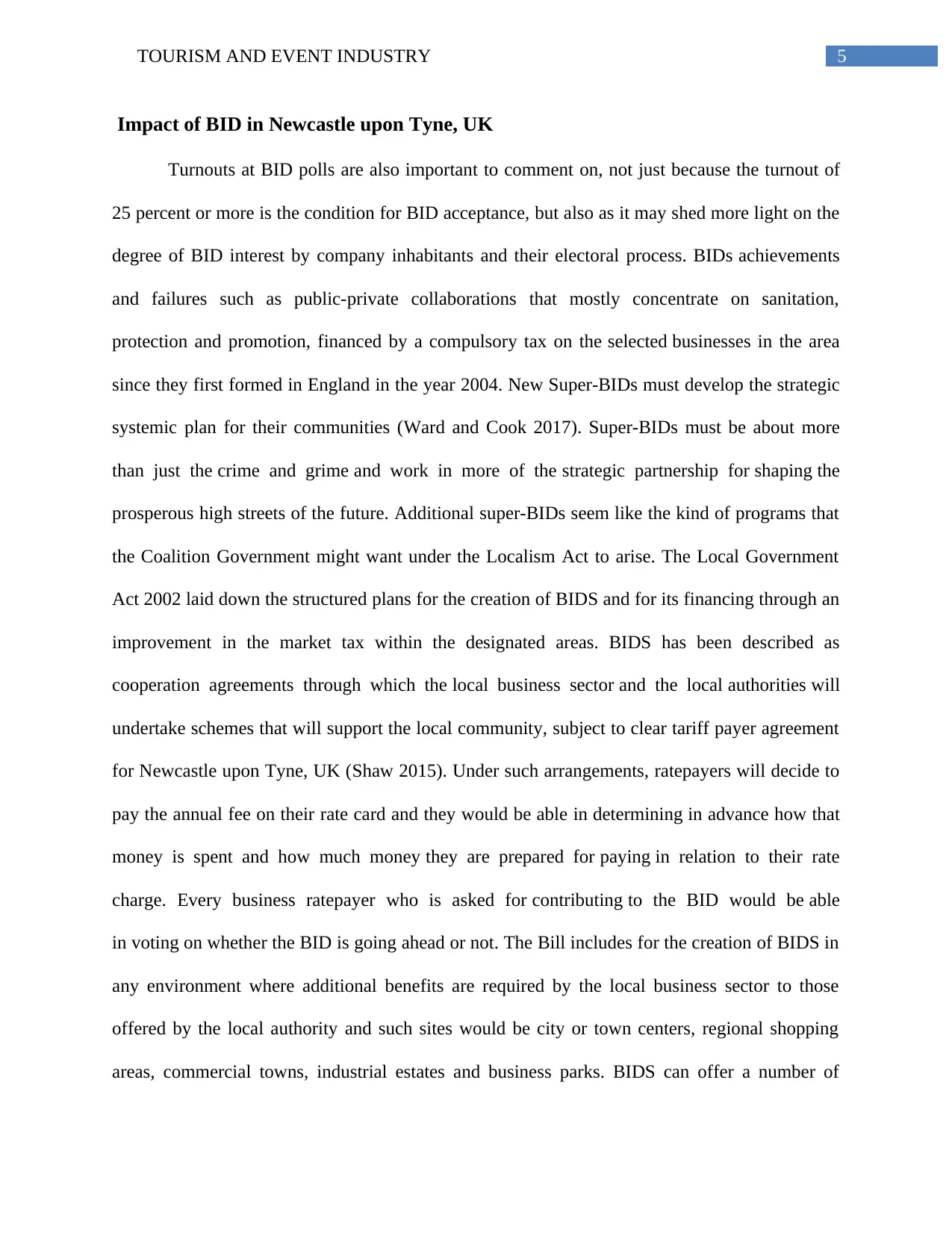
5TOURISM AND EVENT INDUSTRY
Impact of BID in Newcastle upon Tyne, UK
Turnouts at BID polls are also important to comment on, not just because the turnout of
25 percent or more is the condition for BID acceptance, but also as it may shed more light on the
degree of BID interest by company inhabitants and their electoral process. BIDs achievements
and failures such as public-private collaborations that mostly concentrate on sanitation,
protection and promotion, financed by a compulsory tax on the selected businesses in the area
since they first formed in England in the year 2004. New Super-BIDs must develop the strategic
systemic plan for their communities (Ward and Cook 2017). Super-BIDs must be about more
than just the crime and grime and work in more of the strategic partnership for shaping the
prosperous high streets of the future. Additional super-BIDs seem like the kind of programs that
the Coalition Government might want under the Localism Act to arise. The Local Government
Act 2002 laid down the structured plans for the creation of BIDS and for its financing through an
improvement in the market tax within the designated areas. BIDS has been described as
cooperation agreements through which the local business sector and the local authorities will
undertake schemes that will support the local community, subject to clear tariff payer agreement
for Newcastle upon Tyne, UK (Shaw 2015). Under such arrangements, ratepayers will decide to
pay the annual fee on their rate card and they would be able in determining in advance how that
money is spent and how much money they are prepared for paying in relation to their rate
charge. Every business ratepayer who is asked for contributing to the BID would be able
in voting on whether the BID is going ahead or not. The Bill includes for the creation of BIDS in
any environment where additional benefits are required by the local business sector to those
offered by the local authority and such sites would be city or town centers, regional shopping
areas, commercial towns, industrial estates and business parks. BIDS can offer a number of
Impact of BID in Newcastle upon Tyne, UK
Turnouts at BID polls are also important to comment on, not just because the turnout of
25 percent or more is the condition for BID acceptance, but also as it may shed more light on the
degree of BID interest by company inhabitants and their electoral process. BIDs achievements
and failures such as public-private collaborations that mostly concentrate on sanitation,
protection and promotion, financed by a compulsory tax on the selected businesses in the area
since they first formed in England in the year 2004. New Super-BIDs must develop the strategic
systemic plan for their communities (Ward and Cook 2017). Super-BIDs must be about more
than just the crime and grime and work in more of the strategic partnership for shaping the
prosperous high streets of the future. Additional super-BIDs seem like the kind of programs that
the Coalition Government might want under the Localism Act to arise. The Local Government
Act 2002 laid down the structured plans for the creation of BIDS and for its financing through an
improvement in the market tax within the designated areas. BIDS has been described as
cooperation agreements through which the local business sector and the local authorities will
undertake schemes that will support the local community, subject to clear tariff payer agreement
for Newcastle upon Tyne, UK (Shaw 2015). Under such arrangements, ratepayers will decide to
pay the annual fee on their rate card and they would be able in determining in advance how that
money is spent and how much money they are prepared for paying in relation to their rate
charge. Every business ratepayer who is asked for contributing to the BID would be able
in voting on whether the BID is going ahead or not. The Bill includes for the creation of BIDS in
any environment where additional benefits are required by the local business sector to those
offered by the local authority and such sites would be city or town centers, regional shopping
areas, commercial towns, industrial estates and business parks. BIDS can offer a number of
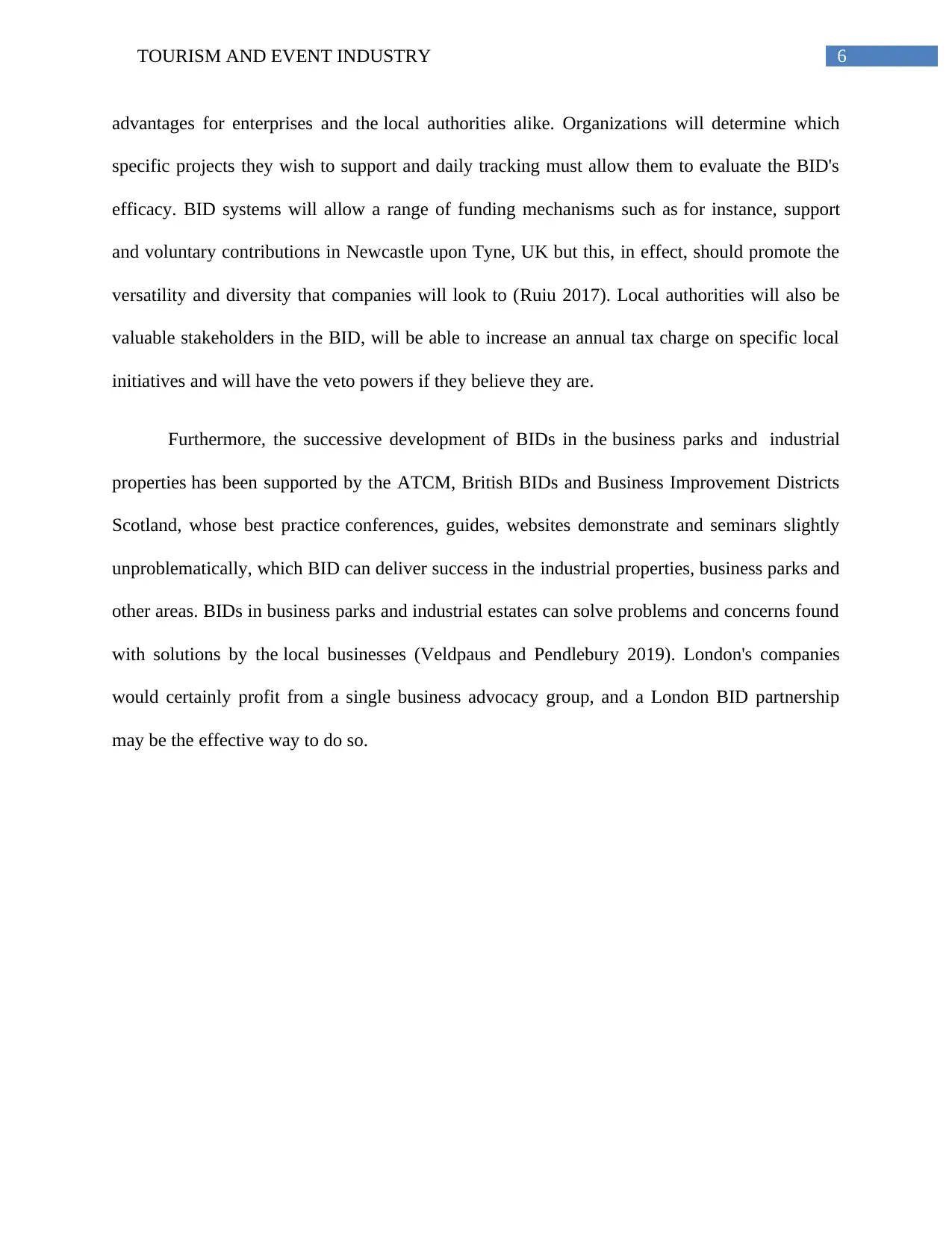
6TOURISM AND EVENT INDUSTRY
advantages for enterprises and the local authorities alike. Organizations will determine which
specific projects they wish to support and daily tracking must allow them to evaluate the BID's
efficacy. BID systems will allow a range of funding mechanisms such as for instance, support
and voluntary contributions in Newcastle upon Tyne, UK but this, in effect, should promote the
versatility and diversity that companies will look to (Ruiu 2017). Local authorities will also be
valuable stakeholders in the BID, will be able to increase an annual tax charge on specific local
initiatives and will have the veto powers if they believe they are.
Furthermore, the successive development of BIDs in the business parks and industrial
properties has been supported by the ATCM, British BIDs and Business Improvement Districts
Scotland, whose best practice conferences, guides, websites demonstrate and seminars slightly
unproblematically, which BID can deliver success in the industrial properties, business parks and
other areas. BIDs in business parks and industrial estates can solve problems and concerns found
with solutions by the local businesses (Veldpaus and Pendlebury 2019). London's companies
would certainly profit from a single business advocacy group, and a London BID partnership
may be the effective way to do so.
advantages for enterprises and the local authorities alike. Organizations will determine which
specific projects they wish to support and daily tracking must allow them to evaluate the BID's
efficacy. BID systems will allow a range of funding mechanisms such as for instance, support
and voluntary contributions in Newcastle upon Tyne, UK but this, in effect, should promote the
versatility and diversity that companies will look to (Ruiu 2017). Local authorities will also be
valuable stakeholders in the BID, will be able to increase an annual tax charge on specific local
initiatives and will have the veto powers if they believe they are.
Furthermore, the successive development of BIDs in the business parks and industrial
properties has been supported by the ATCM, British BIDs and Business Improvement Districts
Scotland, whose best practice conferences, guides, websites demonstrate and seminars slightly
unproblematically, which BID can deliver success in the industrial properties, business parks and
other areas. BIDs in business parks and industrial estates can solve problems and concerns found
with solutions by the local businesses (Veldpaus and Pendlebury 2019). London's companies
would certainly profit from a single business advocacy group, and a London BID partnership
may be the effective way to do so.
Paraphrase This Document
Need a fresh take? Get an instant paraphrase of this document with our AI Paraphraser
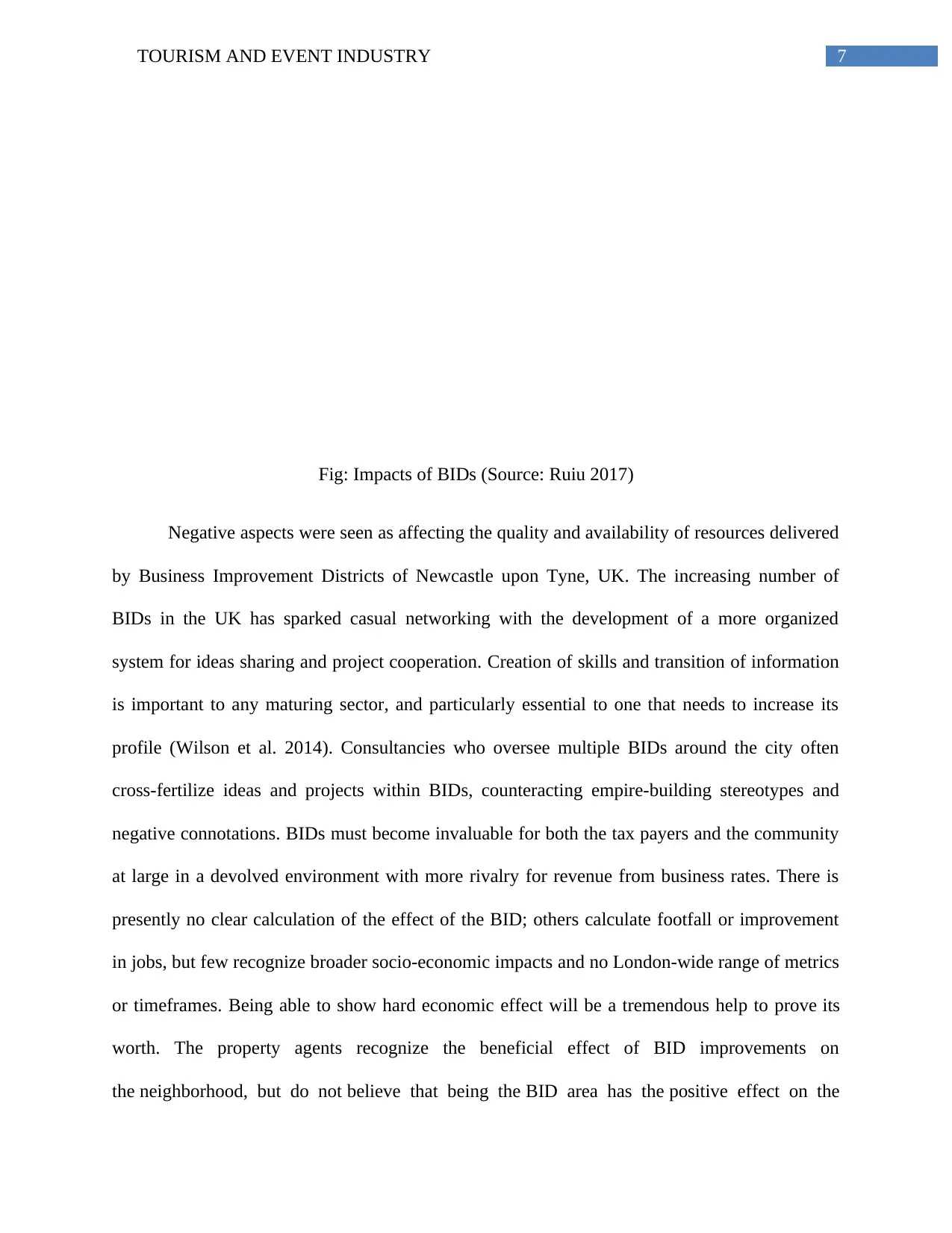
7TOURISM AND EVENT INDUSTRY
Fig: Impacts of BIDs (Source: Ruiu 2017)
Negative aspects were seen as affecting the quality and availability of resources delivered
by Business Improvement Districts of Newcastle upon Tyne, UK. The increasing number of
BIDs in the UK has sparked casual networking with the development of a more organized
system for ideas sharing and project cooperation. Creation of skills and transition of information
is important to any maturing sector, and particularly essential to one that needs to increase its
profile (Wilson et al. 2014). Consultancies who oversee multiple BIDs around the city often
cross-fertilize ideas and projects within BIDs, counteracting empire-building stereotypes and
negative connotations. BIDs must become invaluable for both the tax payers and the community
at large in a devolved environment with more rivalry for revenue from business rates. There is
presently no clear calculation of the effect of the BID; others calculate footfall or improvement
in jobs, but few recognize broader socio-economic impacts and no London-wide range of metrics
or timeframes. Being able to show hard economic effect will be a tremendous help to prove its
worth. The property agents recognize the beneficial effect of BID improvements on
the neighborhood, but do not believe that being the BID area has the positive effect on the
Fig: Impacts of BIDs (Source: Ruiu 2017)
Negative aspects were seen as affecting the quality and availability of resources delivered
by Business Improvement Districts of Newcastle upon Tyne, UK. The increasing number of
BIDs in the UK has sparked casual networking with the development of a more organized
system for ideas sharing and project cooperation. Creation of skills and transition of information
is important to any maturing sector, and particularly essential to one that needs to increase its
profile (Wilson et al. 2014). Consultancies who oversee multiple BIDs around the city often
cross-fertilize ideas and projects within BIDs, counteracting empire-building stereotypes and
negative connotations. BIDs must become invaluable for both the tax payers and the community
at large in a devolved environment with more rivalry for revenue from business rates. There is
presently no clear calculation of the effect of the BID; others calculate footfall or improvement
in jobs, but few recognize broader socio-economic impacts and no London-wide range of metrics
or timeframes. Being able to show hard economic effect will be a tremendous help to prove its
worth. The property agents recognize the beneficial effect of BID improvements on
the neighborhood, but do not believe that being the BID area has the positive effect on the
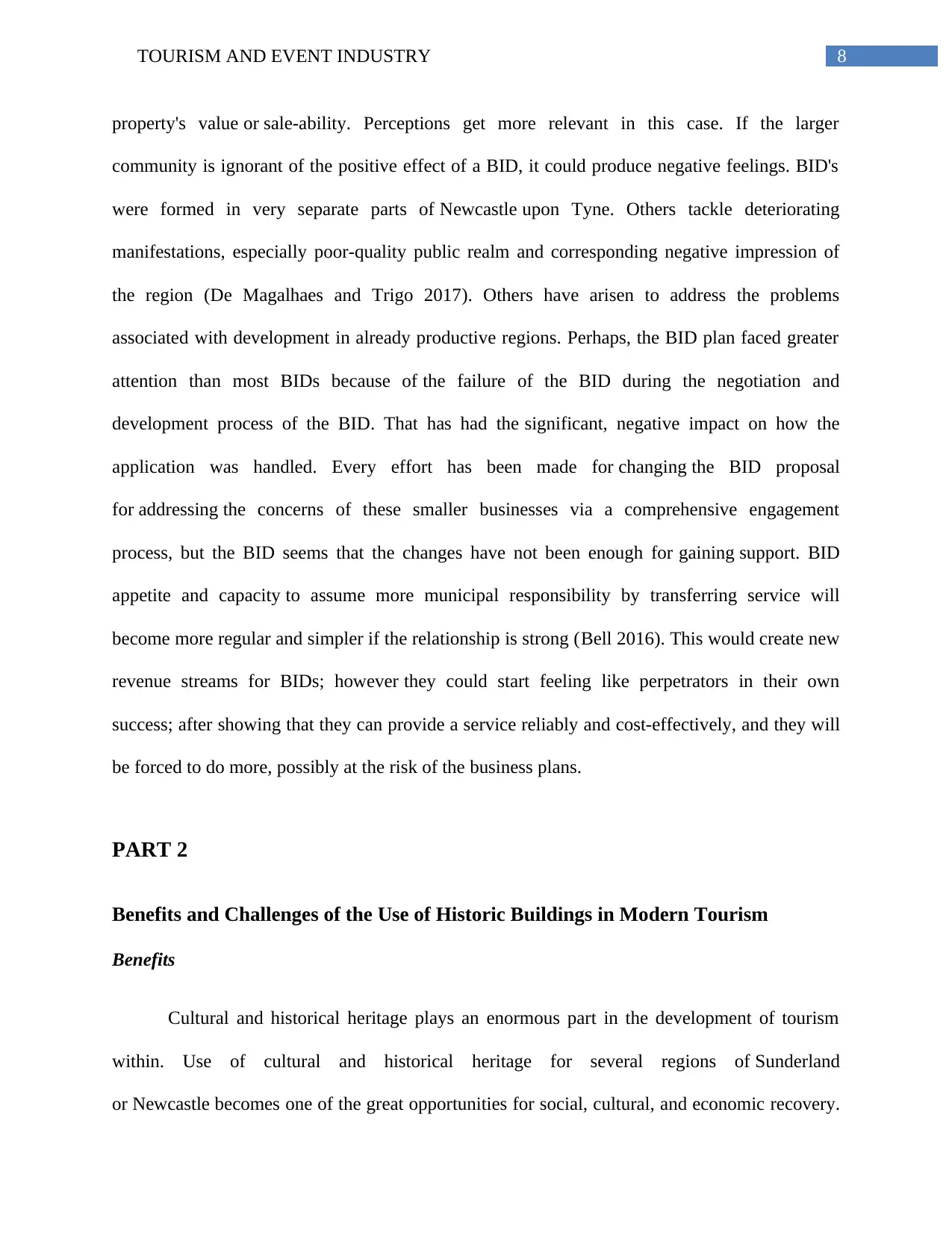
8TOURISM AND EVENT INDUSTRY
property's value or sale-ability. Perceptions get more relevant in this case. If the larger
community is ignorant of the positive effect of a BID, it could produce negative feelings. BID's
were formed in very separate parts of Newcastle upon Tyne. Others tackle deteriorating
manifestations, especially poor-quality public realm and corresponding negative impression of
the region (De Magalhaes and Trigo 2017). Others have arisen to address the problems
associated with development in already productive regions. Perhaps, the BID plan faced greater
attention than most BIDs because of the failure of the BID during the negotiation and
development process of the BID. That has had the significant, negative impact on how the
application was handled. Every effort has been made for changing the BID proposal
for addressing the concerns of these smaller businesses via a comprehensive engagement
process, but the BID seems that the changes have not been enough for gaining support. BID
appetite and capacity to assume more municipal responsibility by transferring service will
become more regular and simpler if the relationship is strong (Bell 2016). This would create new
revenue streams for BIDs; however they could start feeling like perpetrators in their own
success; after showing that they can provide a service reliably and cost-effectively, and they will
be forced to do more, possibly at the risk of the business plans.
PART 2
Benefits and Challenges of the Use of Historic Buildings in Modern Tourism
Benefits
Cultural and historical heritage plays an enormous part in the development of tourism
within. Use of cultural and historical heritage for several regions of Sunderland
or Newcastle becomes one of the great opportunities for social, cultural, and economic recovery.
property's value or sale-ability. Perceptions get more relevant in this case. If the larger
community is ignorant of the positive effect of a BID, it could produce negative feelings. BID's
were formed in very separate parts of Newcastle upon Tyne. Others tackle deteriorating
manifestations, especially poor-quality public realm and corresponding negative impression of
the region (De Magalhaes and Trigo 2017). Others have arisen to address the problems
associated with development in already productive regions. Perhaps, the BID plan faced greater
attention than most BIDs because of the failure of the BID during the negotiation and
development process of the BID. That has had the significant, negative impact on how the
application was handled. Every effort has been made for changing the BID proposal
for addressing the concerns of these smaller businesses via a comprehensive engagement
process, but the BID seems that the changes have not been enough for gaining support. BID
appetite and capacity to assume more municipal responsibility by transferring service will
become more regular and simpler if the relationship is strong (Bell 2016). This would create new
revenue streams for BIDs; however they could start feeling like perpetrators in their own
success; after showing that they can provide a service reliably and cost-effectively, and they will
be forced to do more, possibly at the risk of the business plans.
PART 2
Benefits and Challenges of the Use of Historic Buildings in Modern Tourism
Benefits
Cultural and historical heritage plays an enormous part in the development of tourism
within. Use of cultural and historical heritage for several regions of Sunderland
or Newcastle becomes one of the great opportunities for social, cultural, and economic recovery.
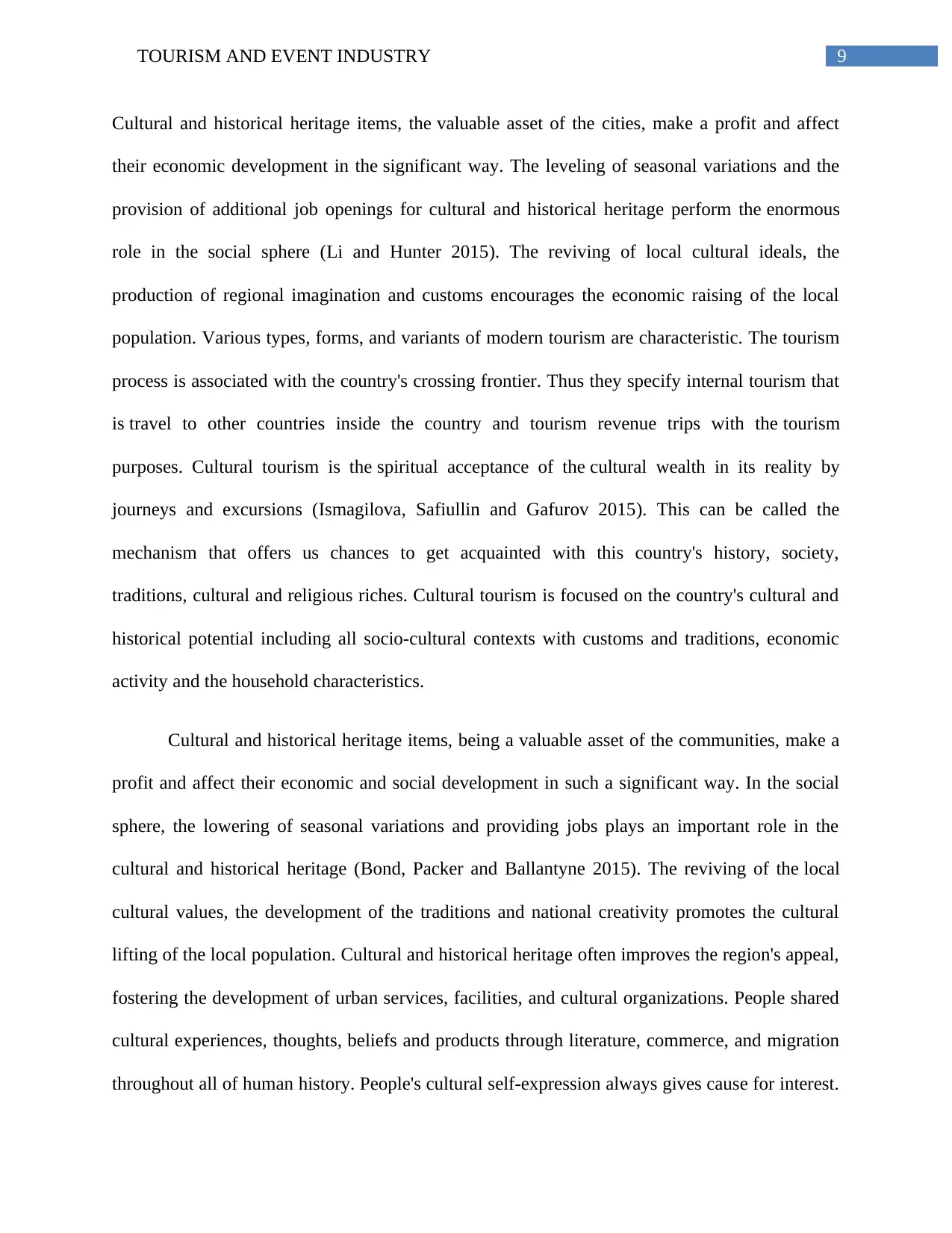
9TOURISM AND EVENT INDUSTRY
Cultural and historical heritage items, the valuable asset of the cities, make a profit and affect
their economic development in the significant way. The leveling of seasonal variations and the
provision of additional job openings for cultural and historical heritage perform the enormous
role in the social sphere (Li and Hunter 2015). The reviving of local cultural ideals, the
production of regional imagination and customs encourages the economic raising of the local
population. Various types, forms, and variants of modern tourism are characteristic. The tourism
process is associated with the country's crossing frontier. Thus they specify internal tourism that
is travel to other countries inside the country and tourism revenue trips with the tourism
purposes. Cultural tourism is the spiritual acceptance of the cultural wealth in its reality by
journeys and excursions (Ismagilova, Safiullin and Gafurov 2015). This can be called the
mechanism that offers us chances to get acquainted with this country's history, society,
traditions, cultural and religious riches. Cultural tourism is focused on the country's cultural and
historical potential including all socio-cultural contexts with customs and traditions, economic
activity and the household characteristics.
Cultural and historical heritage items, being a valuable asset of the communities, make a
profit and affect their economic and social development in such a significant way. In the social
sphere, the lowering of seasonal variations and providing jobs plays an important role in the
cultural and historical heritage (Bond, Packer and Ballantyne 2015). The reviving of the local
cultural values, the development of the traditions and national creativity promotes the cultural
lifting of the local population. Cultural and historical heritage often improves the region's appeal,
fostering the development of urban services, facilities, and cultural organizations. People shared
cultural experiences, thoughts, beliefs and products through literature, commerce, and migration
throughout all of human history. People's cultural self-expression always gives cause for interest.
Cultural and historical heritage items, the valuable asset of the cities, make a profit and affect
their economic development in the significant way. The leveling of seasonal variations and the
provision of additional job openings for cultural and historical heritage perform the enormous
role in the social sphere (Li and Hunter 2015). The reviving of local cultural ideals, the
production of regional imagination and customs encourages the economic raising of the local
population. Various types, forms, and variants of modern tourism are characteristic. The tourism
process is associated with the country's crossing frontier. Thus they specify internal tourism that
is travel to other countries inside the country and tourism revenue trips with the tourism
purposes. Cultural tourism is the spiritual acceptance of the cultural wealth in its reality by
journeys and excursions (Ismagilova, Safiullin and Gafurov 2015). This can be called the
mechanism that offers us chances to get acquainted with this country's history, society,
traditions, cultural and religious riches. Cultural tourism is focused on the country's cultural and
historical potential including all socio-cultural contexts with customs and traditions, economic
activity and the household characteristics.
Cultural and historical heritage items, being a valuable asset of the communities, make a
profit and affect their economic and social development in such a significant way. In the social
sphere, the lowering of seasonal variations and providing jobs plays an important role in the
cultural and historical heritage (Bond, Packer and Ballantyne 2015). The reviving of the local
cultural values, the development of the traditions and national creativity promotes the cultural
lifting of the local population. Cultural and historical heritage often improves the region's appeal,
fostering the development of urban services, facilities, and cultural organizations. People shared
cultural experiences, thoughts, beliefs and products through literature, commerce, and migration
throughout all of human history. People's cultural self-expression always gives cause for interest.
Secure Best Marks with AI Grader
Need help grading? Try our AI Grader for instant feedback on your assignments.
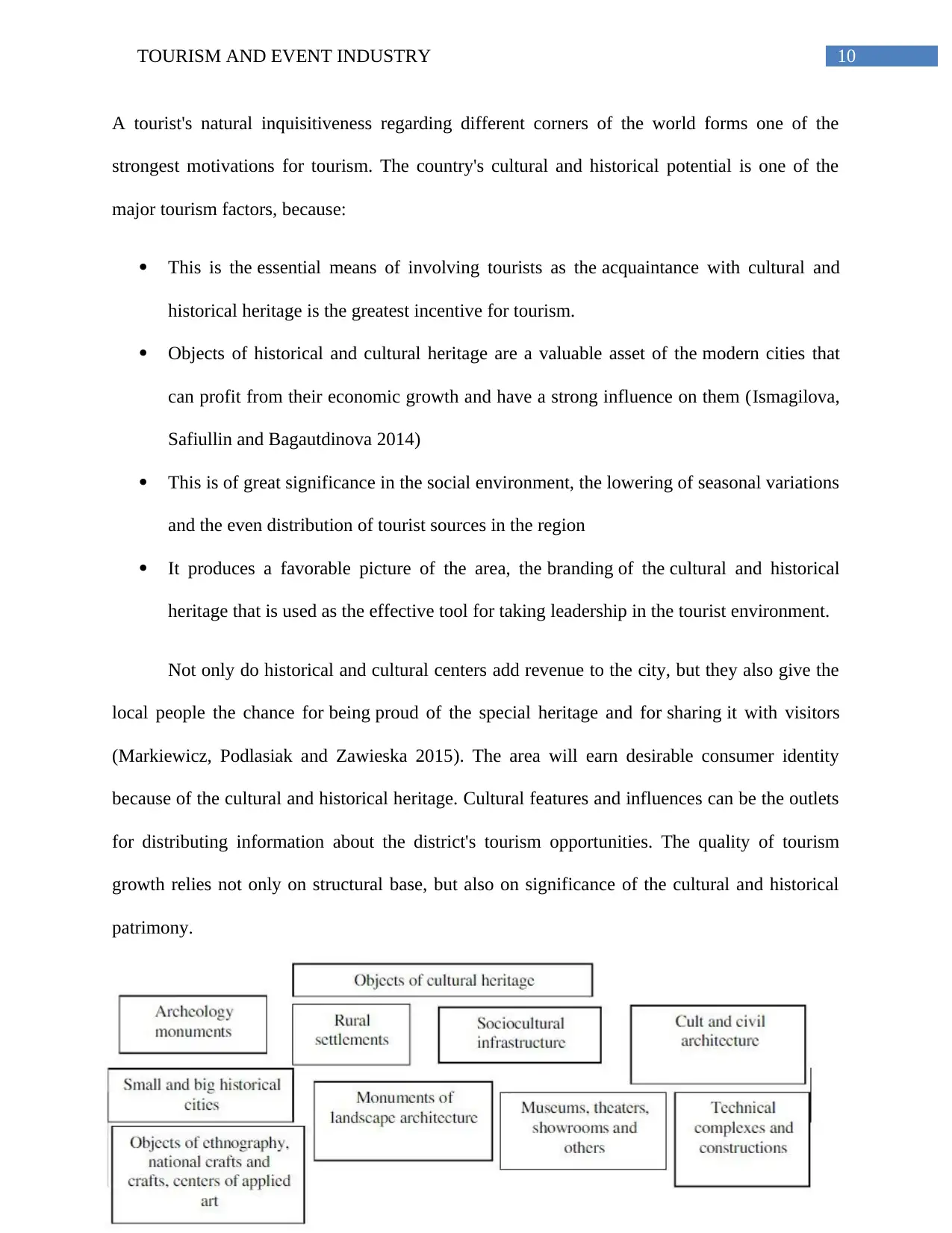
10TOURISM AND EVENT INDUSTRY
A tourist's natural inquisitiveness regarding different corners of the world forms one of the
strongest motivations for tourism. The country's cultural and historical potential is one of the
major tourism factors, because:
This is the essential means of involving tourists as the acquaintance with cultural and
historical heritage is the greatest incentive for tourism.
Objects of historical and cultural heritage are a valuable asset of the modern cities that
can profit from their economic growth and have a strong influence on them (Ismagilova,
Safiullin and Bagautdinova 2014)
This is of great significance in the social environment, the lowering of seasonal variations
and the even distribution of tourist sources in the region
It produces a favorable picture of the area, the branding of the cultural and historical
heritage that is used as the effective tool for taking leadership in the tourist environment.
Not only do historical and cultural centers add revenue to the city, but they also give the
local people the chance for being proud of the special heritage and for sharing it with visitors
(Markiewicz, Podlasiak and Zawieska 2015). The area will earn desirable consumer identity
because of the cultural and historical heritage. Cultural features and influences can be the outlets
for distributing information about the district's tourism opportunities. The quality of tourism
growth relies not only on structural base, but also on significance of the cultural and historical
patrimony.
A tourist's natural inquisitiveness regarding different corners of the world forms one of the
strongest motivations for tourism. The country's cultural and historical potential is one of the
major tourism factors, because:
This is the essential means of involving tourists as the acquaintance with cultural and
historical heritage is the greatest incentive for tourism.
Objects of historical and cultural heritage are a valuable asset of the modern cities that
can profit from their economic growth and have a strong influence on them (Ismagilova,
Safiullin and Bagautdinova 2014)
This is of great significance in the social environment, the lowering of seasonal variations
and the even distribution of tourist sources in the region
It produces a favorable picture of the area, the branding of the cultural and historical
heritage that is used as the effective tool for taking leadership in the tourist environment.
Not only do historical and cultural centers add revenue to the city, but they also give the
local people the chance for being proud of the special heritage and for sharing it with visitors
(Markiewicz, Podlasiak and Zawieska 2015). The area will earn desirable consumer identity
because of the cultural and historical heritage. Cultural features and influences can be the outlets
for distributing information about the district's tourism opportunities. The quality of tourism
growth relies not only on structural base, but also on significance of the cultural and historical
patrimony.
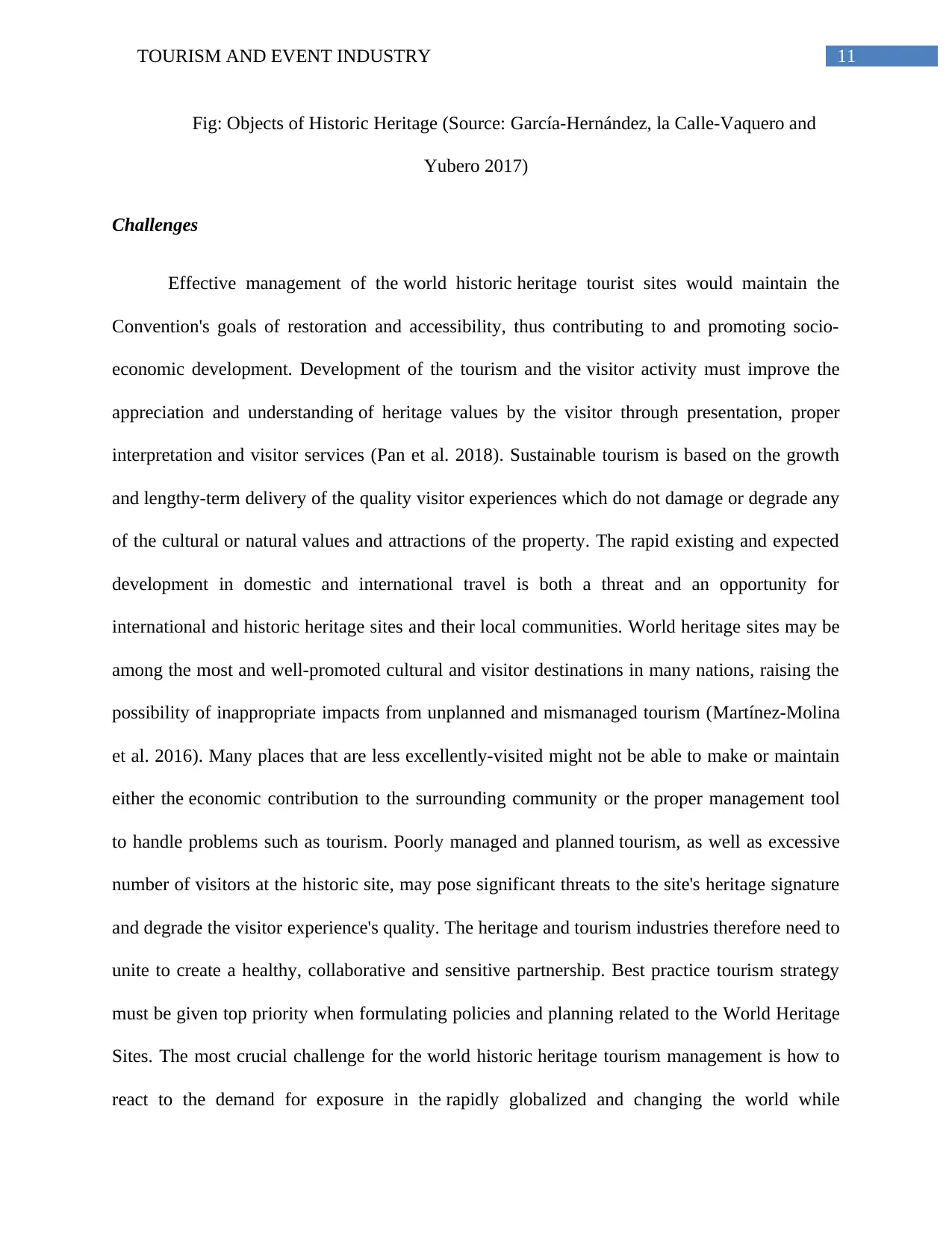
11TOURISM AND EVENT INDUSTRY
Fig: Objects of Historic Heritage (Source: García-Hernández, la Calle-Vaquero and
Yubero 2017)
Challenges
Effective management of the world historic heritage tourist sites would maintain the
Convention's goals of restoration and accessibility, thus contributing to and promoting socio-
economic development. Development of the tourism and the visitor activity must improve the
appreciation and understanding of heritage values by the visitor through presentation, proper
interpretation and visitor services (Pan et al. 2018). Sustainable tourism is based on the growth
and lengthy-term delivery of the quality visitor experiences which do not damage or degrade any
of the cultural or natural values and attractions of the property. The rapid existing and expected
development in domestic and international travel is both a threat and an opportunity for
international and historic heritage sites and their local communities. World heritage sites may be
among the most and well-promoted cultural and visitor destinations in many nations, raising the
possibility of inappropriate impacts from unplanned and mismanaged tourism (Martínez-Molina
et al. 2016). Many places that are less excellently-visited might not be able to make or maintain
either the economic contribution to the surrounding community or the proper management tool
to handle problems such as tourism. Poorly managed and planned tourism, as well as excessive
number of visitors at the historic site, may pose significant threats to the site's heritage signature
and degrade the visitor experience's quality. The heritage and tourism industries therefore need to
unite to create a healthy, collaborative and sensitive partnership. Best practice tourism strategy
must be given top priority when formulating policies and planning related to the World Heritage
Sites. The most crucial challenge for the world historic heritage tourism management is how to
react to the demand for exposure in the rapidly globalized and changing the world while
Fig: Objects of Historic Heritage (Source: García-Hernández, la Calle-Vaquero and
Yubero 2017)
Challenges
Effective management of the world historic heritage tourist sites would maintain the
Convention's goals of restoration and accessibility, thus contributing to and promoting socio-
economic development. Development of the tourism and the visitor activity must improve the
appreciation and understanding of heritage values by the visitor through presentation, proper
interpretation and visitor services (Pan et al. 2018). Sustainable tourism is based on the growth
and lengthy-term delivery of the quality visitor experiences which do not damage or degrade any
of the cultural or natural values and attractions of the property. The rapid existing and expected
development in domestic and international travel is both a threat and an opportunity for
international and historic heritage sites and their local communities. World heritage sites may be
among the most and well-promoted cultural and visitor destinations in many nations, raising the
possibility of inappropriate impacts from unplanned and mismanaged tourism (Martínez-Molina
et al. 2016). Many places that are less excellently-visited might not be able to make or maintain
either the economic contribution to the surrounding community or the proper management tool
to handle problems such as tourism. Poorly managed and planned tourism, as well as excessive
number of visitors at the historic site, may pose significant threats to the site's heritage signature
and degrade the visitor experience's quality. The heritage and tourism industries therefore need to
unite to create a healthy, collaborative and sensitive partnership. Best practice tourism strategy
must be given top priority when formulating policies and planning related to the World Heritage
Sites. The most crucial challenge for the world historic heritage tourism management is how to
react to the demand for exposure in the rapidly globalized and changing the world while
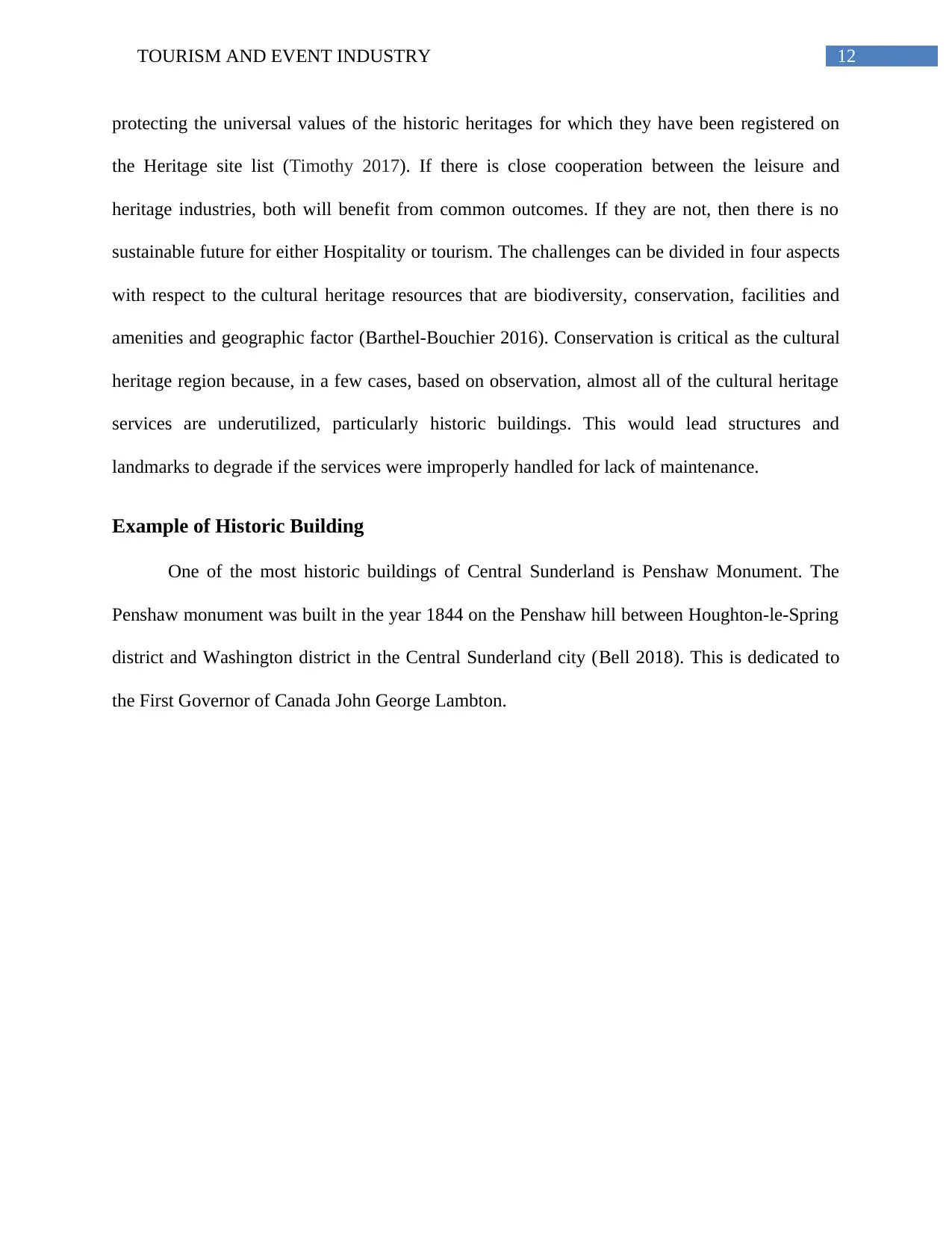
12TOURISM AND EVENT INDUSTRY
protecting the universal values of the historic heritages for which they have been registered on
the Heritage site list (Timothy 2017). If there is close cooperation between the leisure and
heritage industries, both will benefit from common outcomes. If they are not, then there is no
sustainable future for either Hospitality or tourism. The challenges can be divided in four aspects
with respect to the cultural heritage resources that are biodiversity, conservation, facilities and
amenities and geographic factor (Barthel-Bouchier 2016). Conservation is critical as the cultural
heritage region because, in a few cases, based on observation, almost all of the cultural heritage
services are underutilized, particularly historic buildings. This would lead structures and
landmarks to degrade if the services were improperly handled for lack of maintenance.
Example of Historic Building
One of the most historic buildings of Central Sunderland is Penshaw Monument. The
Penshaw monument was built in the year 1844 on the Penshaw hill between Houghton-le-Spring
district and Washington district in the Central Sunderland city (Bell 2018). This is dedicated to
the First Governor of Canada John George Lambton.
protecting the universal values of the historic heritages for which they have been registered on
the Heritage site list (Timothy 2017). If there is close cooperation between the leisure and
heritage industries, both will benefit from common outcomes. If they are not, then there is no
sustainable future for either Hospitality or tourism. The challenges can be divided in four aspects
with respect to the cultural heritage resources that are biodiversity, conservation, facilities and
amenities and geographic factor (Barthel-Bouchier 2016). Conservation is critical as the cultural
heritage region because, in a few cases, based on observation, almost all of the cultural heritage
services are underutilized, particularly historic buildings. This would lead structures and
landmarks to degrade if the services were improperly handled for lack of maintenance.
Example of Historic Building
One of the most historic buildings of Central Sunderland is Penshaw Monument. The
Penshaw monument was built in the year 1844 on the Penshaw hill between Houghton-le-Spring
district and Washington district in the Central Sunderland city (Bell 2018). This is dedicated to
the First Governor of Canada John George Lambton.
Paraphrase This Document
Need a fresh take? Get an instant paraphrase of this document with our AI Paraphraser
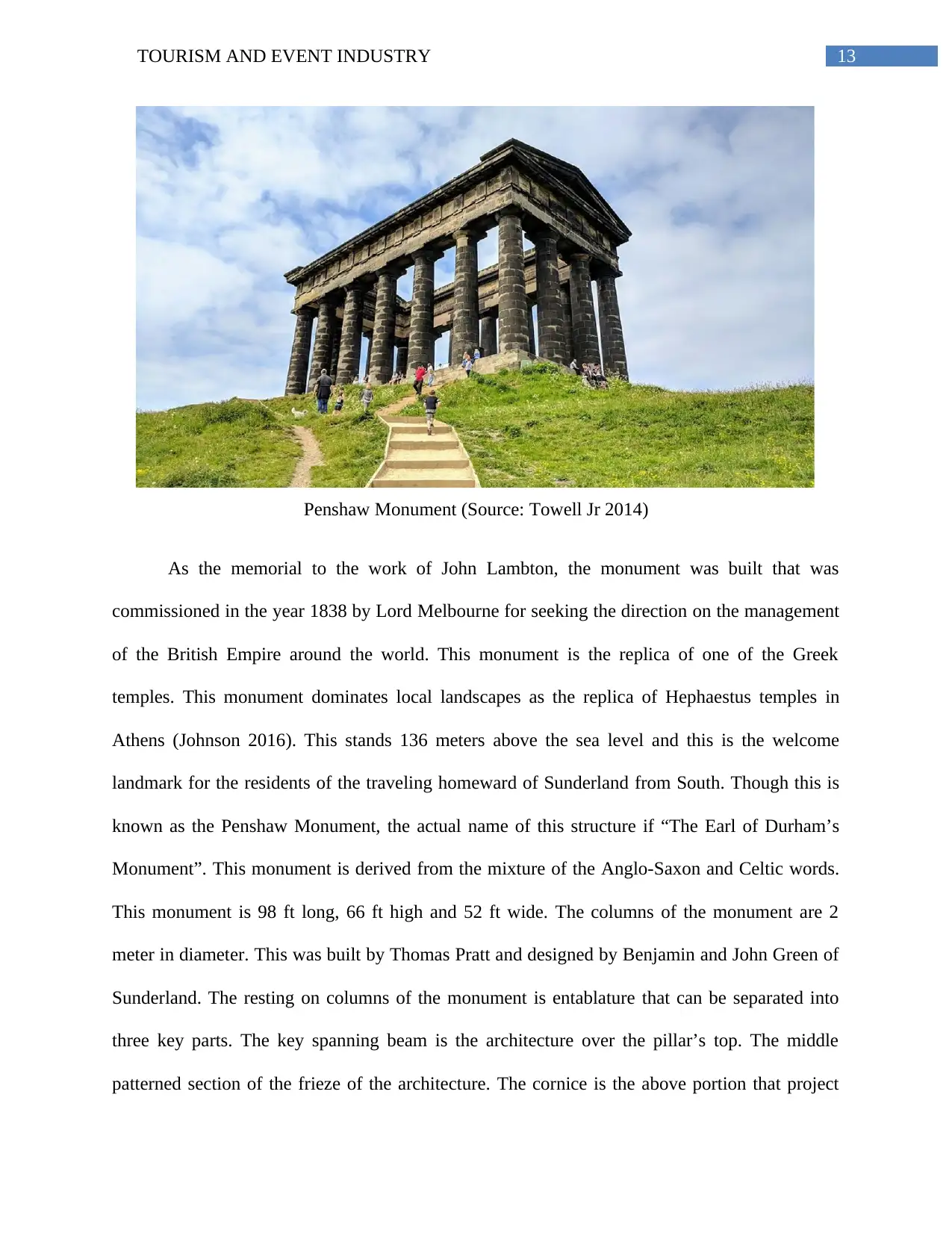
13TOURISM AND EVENT INDUSTRY
Penshaw Monument (Source: Towell Jr 2014)
As the memorial to the work of John Lambton, the monument was built that was
commissioned in the year 1838 by Lord Melbourne for seeking the direction on the management
of the British Empire around the world. This monument is the replica of one of the Greek
temples. This monument dominates local landscapes as the replica of Hephaestus temples in
Athens (Johnson 2016). This stands 136 meters above the sea level and this is the welcome
landmark for the residents of the traveling homeward of Sunderland from South. Though this is
known as the Penshaw Monument, the actual name of this structure if “The Earl of Durham’s
Monument”. This monument is derived from the mixture of the Anglo-Saxon and Celtic words.
This monument is 98 ft long, 66 ft high and 52 ft wide. The columns of the monument are 2
meter in diameter. This was built by Thomas Pratt and designed by Benjamin and John Green of
Sunderland. The resting on columns of the monument is entablature that can be separated into
three key parts. The key spanning beam is the architecture over the pillar’s top. The middle
patterned section of the frieze of the architecture. The cornice is the above portion that project
Penshaw Monument (Source: Towell Jr 2014)
As the memorial to the work of John Lambton, the monument was built that was
commissioned in the year 1838 by Lord Melbourne for seeking the direction on the management
of the British Empire around the world. This monument is the replica of one of the Greek
temples. This monument dominates local landscapes as the replica of Hephaestus temples in
Athens (Johnson 2016). This stands 136 meters above the sea level and this is the welcome
landmark for the residents of the traveling homeward of Sunderland from South. Though this is
known as the Penshaw Monument, the actual name of this structure if “The Earl of Durham’s
Monument”. This monument is derived from the mixture of the Anglo-Saxon and Celtic words.
This monument is 98 ft long, 66 ft high and 52 ft wide. The columns of the monument are 2
meter in diameter. This was built by Thomas Pratt and designed by Benjamin and John Green of
Sunderland. The resting on columns of the monument is entablature that can be separated into
three key parts. The key spanning beam is the architecture over the pillar’s top. The middle
patterned section of the frieze of the architecture. The cornice is the above portion that project
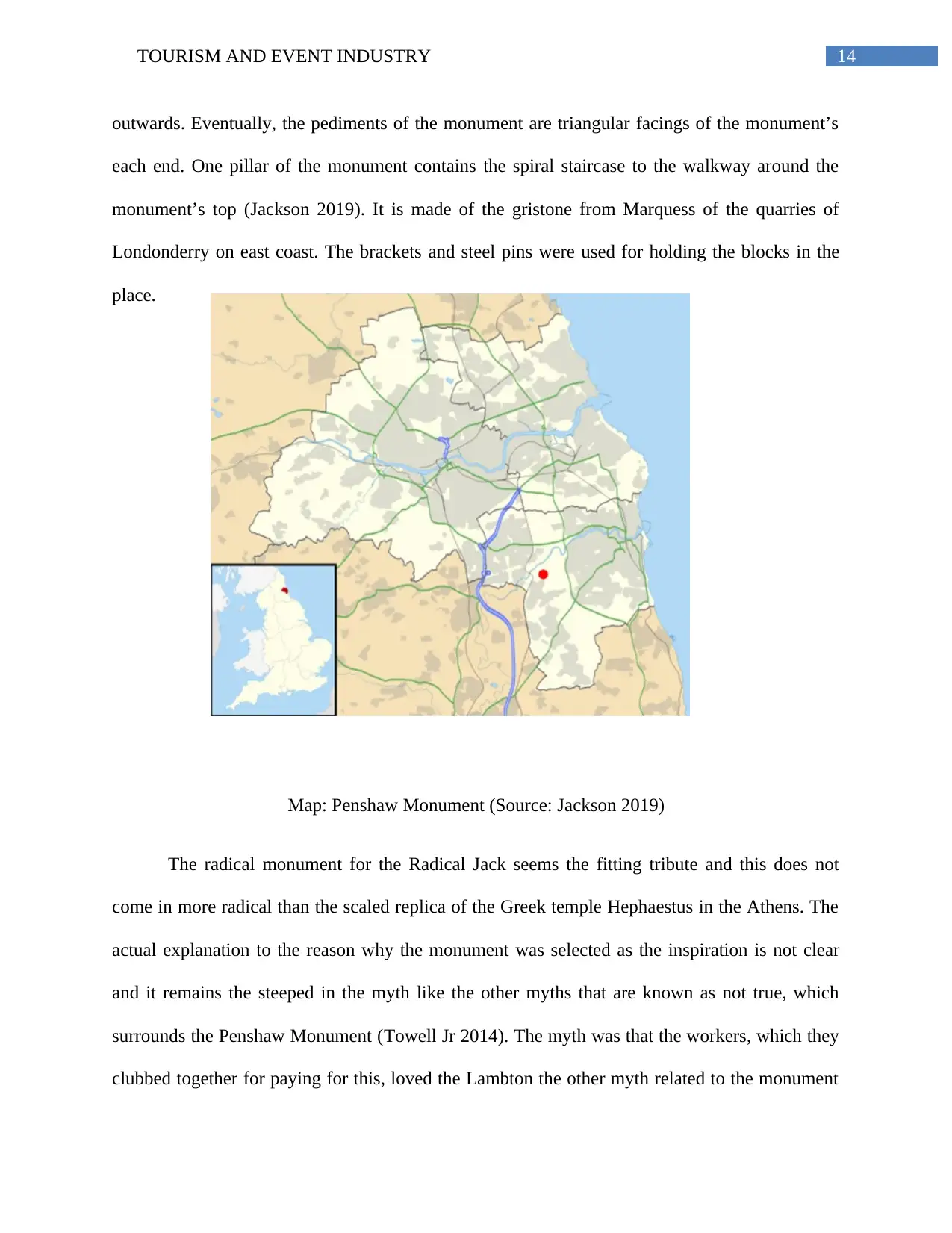
14TOURISM AND EVENT INDUSTRY
outwards. Eventually, the pediments of the monument are triangular facings of the monument’s
each end. One pillar of the monument contains the spiral staircase to the walkway around the
monument’s top (Jackson 2019). It is made of the gristone from Marquess of the quarries of
Londonderry on east coast. The brackets and steel pins were used for holding the blocks in the
place.
Map: Penshaw Monument (Source: Jackson 2019)
The radical monument for the Radical Jack seems the fitting tribute and this does not
come in more radical than the scaled replica of the Greek temple Hephaestus in the Athens. The
actual explanation to the reason why the monument was selected as the inspiration is not clear
and it remains the steeped in the myth like the other myths that are known as not true, which
surrounds the Penshaw Monument (Towell Jr 2014). The myth was that the workers, which they
clubbed together for paying for this, loved the Lambton the other myth related to the monument
outwards. Eventually, the pediments of the monument are triangular facings of the monument’s
each end. One pillar of the monument contains the spiral staircase to the walkway around the
monument’s top (Jackson 2019). It is made of the gristone from Marquess of the quarries of
Londonderry on east coast. The brackets and steel pins were used for holding the blocks in the
place.
Map: Penshaw Monument (Source: Jackson 2019)
The radical monument for the Radical Jack seems the fitting tribute and this does not
come in more radical than the scaled replica of the Greek temple Hephaestus in the Athens. The
actual explanation to the reason why the monument was selected as the inspiration is not clear
and it remains the steeped in the myth like the other myths that are known as not true, which
surrounds the Penshaw Monument (Towell Jr 2014). The myth was that the workers, which they
clubbed together for paying for this, loved the Lambton the other myth related to the monument

15TOURISM AND EVENT INDUSTRY
that while Radical jack rode the and he saw this and he used to rise the rents of every person for
punishing them to spend the money on the frivolous things. No doubt is there, whatever the
myths and the truth is that the Penshaw Monument holds the special place in the affections of the
region and this was easy for seeing the reason why this was becoming the firm achieved and
favorite like the iconic status.
Many things has newly established there such as the new high tech CCTV and
floodlighting system will be there for trailed at the Penshaw Monument. This can be great for the
surroundings area as this will make the place more sophisticated. 18 LED lights are installed at
every pillar’s base for allowing the white and softer effect and the floodlights on the monuments
can be programmed for displaying the color changing effect of light by meaning thee special
events or anniversaries like football or cricket celebration can be highlighted in various colors on
that landmark. This thing will attract more tourists and will help the surroundings area to grow.
The investment of £43,000 will minimize the cost of the energy by around 80% and will save the
running cost up to £8,000 per year.
that while Radical jack rode the and he saw this and he used to rise the rents of every person for
punishing them to spend the money on the frivolous things. No doubt is there, whatever the
myths and the truth is that the Penshaw Monument holds the special place in the affections of the
region and this was easy for seeing the reason why this was becoming the firm achieved and
favorite like the iconic status.
Many things has newly established there such as the new high tech CCTV and
floodlighting system will be there for trailed at the Penshaw Monument. This can be great for the
surroundings area as this will make the place more sophisticated. 18 LED lights are installed at
every pillar’s base for allowing the white and softer effect and the floodlights on the monuments
can be programmed for displaying the color changing effect of light by meaning thee special
events or anniversaries like football or cricket celebration can be highlighted in various colors on
that landmark. This thing will attract more tourists and will help the surroundings area to grow.
The investment of £43,000 will minimize the cost of the energy by around 80% and will save the
running cost up to £8,000 per year.
Secure Best Marks with AI Grader
Need help grading? Try our AI Grader for instant feedback on your assignments.
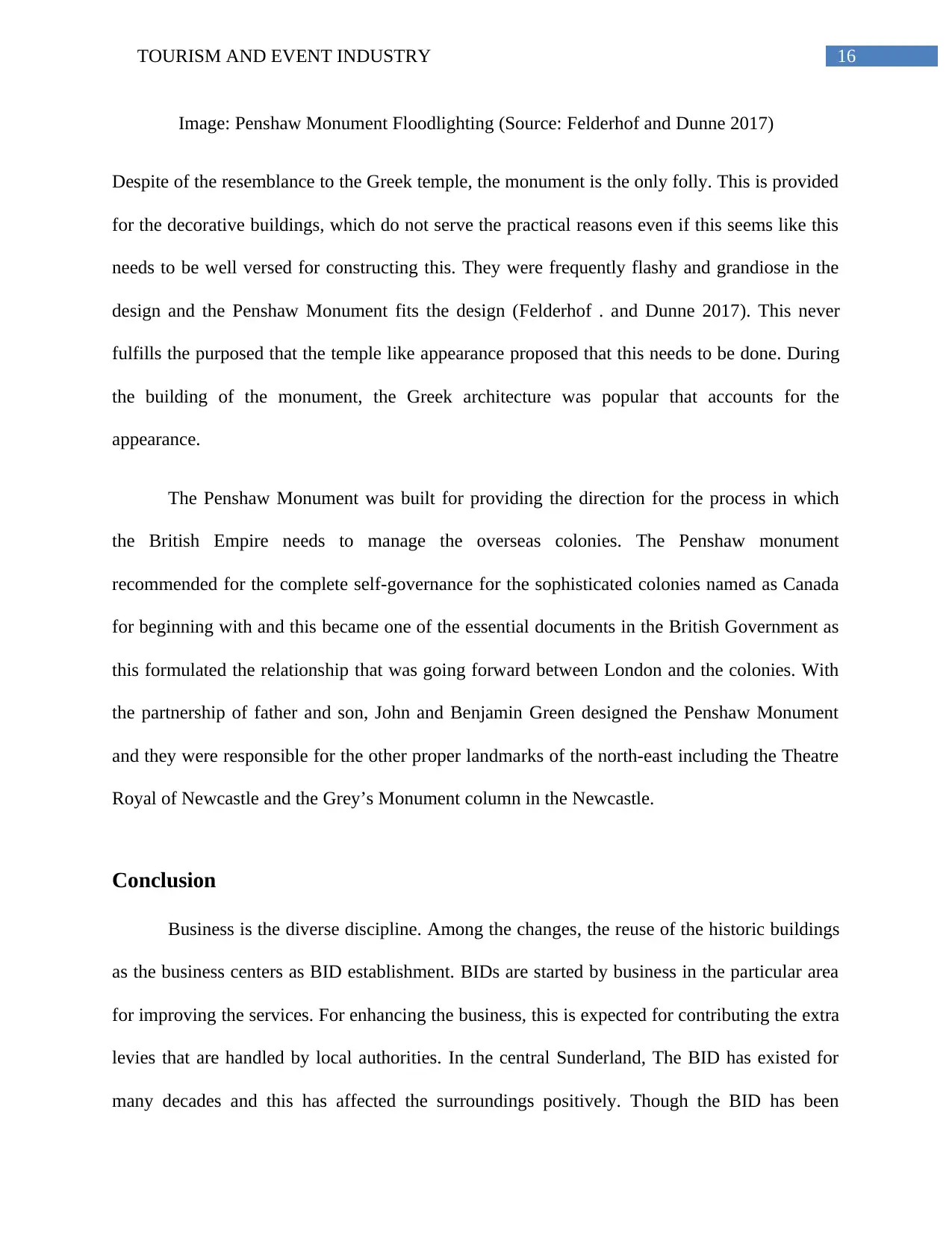
16TOURISM AND EVENT INDUSTRY
Image: Penshaw Monument Floodlighting (Source: Felderhof and Dunne 2017)
Despite of the resemblance to the Greek temple, the monument is the only folly. This is provided
for the decorative buildings, which do not serve the practical reasons even if this seems like this
needs to be well versed for constructing this. They were frequently flashy and grandiose in the
design and the Penshaw Monument fits the design (Felderhof . and Dunne 2017). This never
fulfills the purposed that the temple like appearance proposed that this needs to be done. During
the building of the monument, the Greek architecture was popular that accounts for the
appearance.
The Penshaw Monument was built for providing the direction for the process in which
the British Empire needs to manage the overseas colonies. The Penshaw monument
recommended for the complete self-governance for the sophisticated colonies named as Canada
for beginning with and this became one of the essential documents in the British Government as
this formulated the relationship that was going forward between London and the colonies. With
the partnership of father and son, John and Benjamin Green designed the Penshaw Monument
and they were responsible for the other proper landmarks of the north-east including the Theatre
Royal of Newcastle and the Grey’s Monument column in the Newcastle.
Conclusion
Business is the diverse discipline. Among the changes, the reuse of the historic buildings
as the business centers as BID establishment. BIDs are started by business in the particular area
for improving the services. For enhancing the business, this is expected for contributing the extra
levies that are handled by local authorities. In the central Sunderland, The BID has existed for
many decades and this has affected the surroundings positively. Though the BID has been
Image: Penshaw Monument Floodlighting (Source: Felderhof and Dunne 2017)
Despite of the resemblance to the Greek temple, the monument is the only folly. This is provided
for the decorative buildings, which do not serve the practical reasons even if this seems like this
needs to be well versed for constructing this. They were frequently flashy and grandiose in the
design and the Penshaw Monument fits the design (Felderhof . and Dunne 2017). This never
fulfills the purposed that the temple like appearance proposed that this needs to be done. During
the building of the monument, the Greek architecture was popular that accounts for the
appearance.
The Penshaw Monument was built for providing the direction for the process in which
the British Empire needs to manage the overseas colonies. The Penshaw monument
recommended for the complete self-governance for the sophisticated colonies named as Canada
for beginning with and this became one of the essential documents in the British Government as
this formulated the relationship that was going forward between London and the colonies. With
the partnership of father and son, John and Benjamin Green designed the Penshaw Monument
and they were responsible for the other proper landmarks of the north-east including the Theatre
Royal of Newcastle and the Grey’s Monument column in the Newcastle.
Conclusion
Business is the diverse discipline. Among the changes, the reuse of the historic buildings
as the business centers as BID establishment. BIDs are started by business in the particular area
for improving the services. For enhancing the business, this is expected for contributing the extra
levies that are handled by local authorities. In the central Sunderland, The BID has existed for
many decades and this has affected the surroundings positively. Though the BID has been

17TOURISM AND EVENT INDUSTRY
praised to change the multiple aspects in the neighborhood and business centers, this still has
continued for raising the controversies. The controversies about the BIDs are connected with the
accountability and security in collected levies management. The other aspect in the business is
reusing the historic buildings for the business purpose and the establishment of the hospitality
centers, tourism centers and leisure centers.
praised to change the multiple aspects in the neighborhood and business centers, this still has
continued for raising the controversies. The controversies about the BIDs are connected with the
accountability and security in collected levies management. The other aspect in the business is
reusing the historic buildings for the business purpose and the establishment of the hospitality
centers, tourism centers and leisure centers.
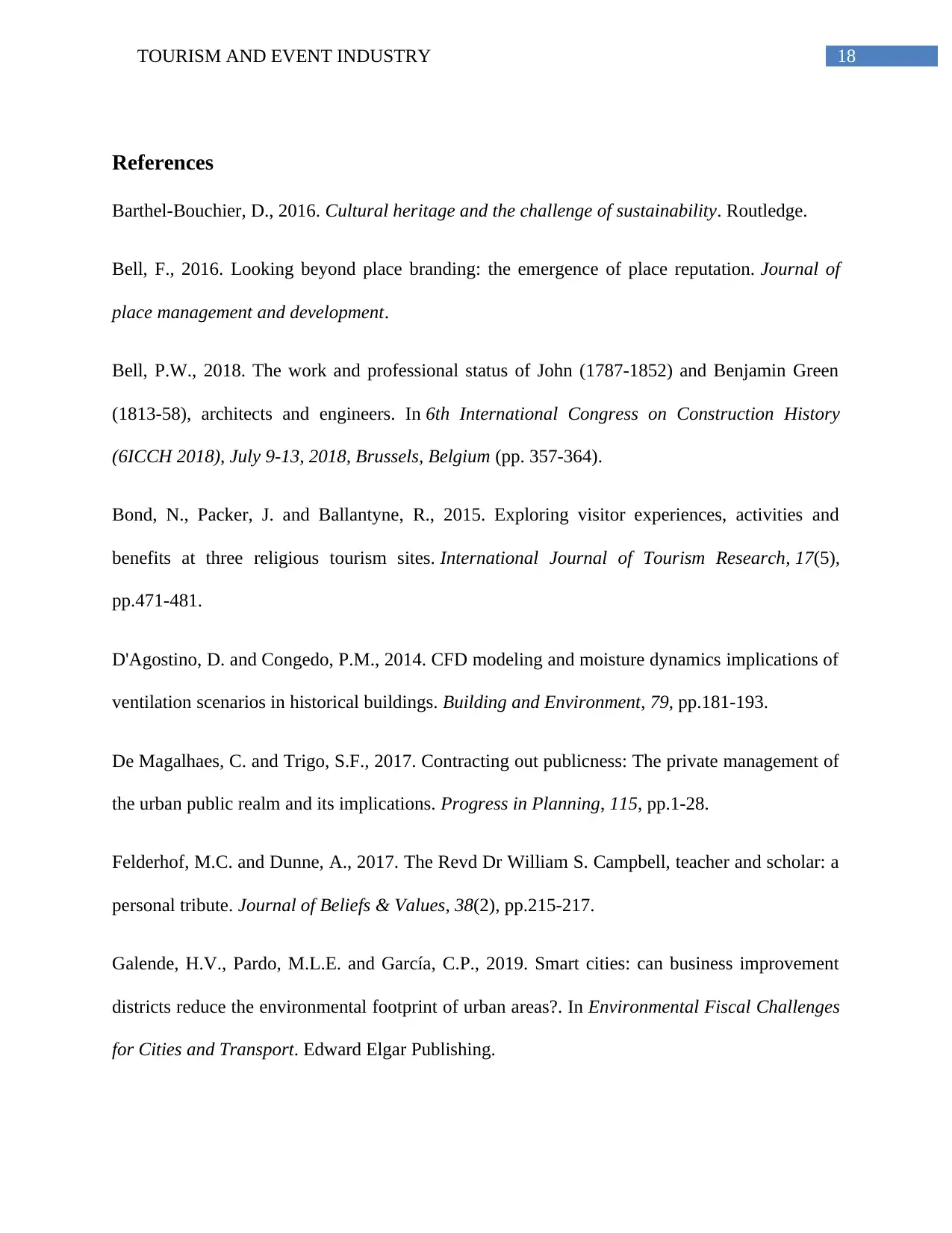
18TOURISM AND EVENT INDUSTRY
References
Barthel-Bouchier, D., 2016. Cultural heritage and the challenge of sustainability. Routledge.
Bell, F., 2016. Looking beyond place branding: the emergence of place reputation. Journal of
place management and development.
Bell, P.W., 2018. The work and professional status of John (1787-1852) and Benjamin Green
(1813-58), architects and engineers. In 6th International Congress on Construction History
(6ICCH 2018), July 9-13, 2018, Brussels, Belgium (pp. 357-364).
Bond, N., Packer, J. and Ballantyne, R., 2015. Exploring visitor experiences, activities and
benefits at three religious tourism sites. International Journal of Tourism Research, 17(5),
pp.471-481.
D'Agostino, D. and Congedo, P.M., 2014. CFD modeling and moisture dynamics implications of
ventilation scenarios in historical buildings. Building and Environment, 79, pp.181-193.
De Magalhaes, C. and Trigo, S.F., 2017. Contracting out publicness: The private management of
the urban public realm and its implications. Progress in Planning, 115, pp.1-28.
Felderhof, M.C. and Dunne, A., 2017. The Revd Dr William S. Campbell, teacher and scholar: a
personal tribute. Journal of Beliefs & Values, 38(2), pp.215-217.
Galende, H.V., Pardo, M.L.E. and García, C.P., 2019. Smart cities: can business improvement
districts reduce the environmental footprint of urban areas?. In Environmental Fiscal Challenges
for Cities and Transport. Edward Elgar Publishing.
References
Barthel-Bouchier, D., 2016. Cultural heritage and the challenge of sustainability. Routledge.
Bell, F., 2016. Looking beyond place branding: the emergence of place reputation. Journal of
place management and development.
Bell, P.W., 2018. The work and professional status of John (1787-1852) and Benjamin Green
(1813-58), architects and engineers. In 6th International Congress on Construction History
(6ICCH 2018), July 9-13, 2018, Brussels, Belgium (pp. 357-364).
Bond, N., Packer, J. and Ballantyne, R., 2015. Exploring visitor experiences, activities and
benefits at three religious tourism sites. International Journal of Tourism Research, 17(5),
pp.471-481.
D'Agostino, D. and Congedo, P.M., 2014. CFD modeling and moisture dynamics implications of
ventilation scenarios in historical buildings. Building and Environment, 79, pp.181-193.
De Magalhaes, C. and Trigo, S.F., 2017. Contracting out publicness: The private management of
the urban public realm and its implications. Progress in Planning, 115, pp.1-28.
Felderhof, M.C. and Dunne, A., 2017. The Revd Dr William S. Campbell, teacher and scholar: a
personal tribute. Journal of Beliefs & Values, 38(2), pp.215-217.
Galende, H.V., Pardo, M.L.E. and García, C.P., 2019. Smart cities: can business improvement
districts reduce the environmental footprint of urban areas?. In Environmental Fiscal Challenges
for Cities and Transport. Edward Elgar Publishing.
Paraphrase This Document
Need a fresh take? Get an instant paraphrase of this document with our AI Paraphraser
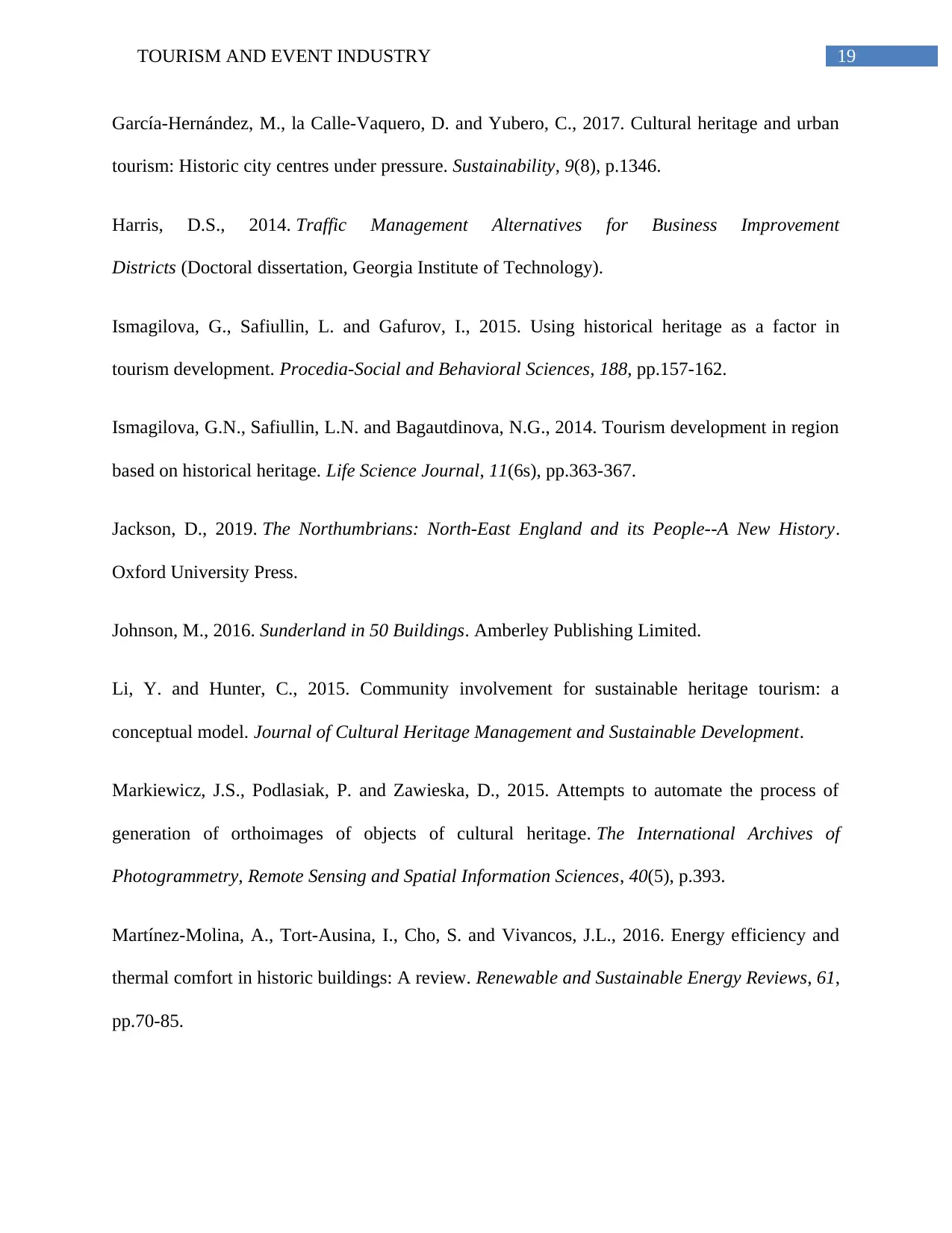
19TOURISM AND EVENT INDUSTRY
García-Hernández, M., la Calle-Vaquero, D. and Yubero, C., 2017. Cultural heritage and urban
tourism: Historic city centres under pressure. Sustainability, 9(8), p.1346.
Harris, D.S., 2014. Traffic Management Alternatives for Business Improvement
Districts (Doctoral dissertation, Georgia Institute of Technology).
Ismagilova, G., Safiullin, L. and Gafurov, I., 2015. Using historical heritage as a factor in
tourism development. Procedia-Social and Behavioral Sciences, 188, pp.157-162.
Ismagilova, G.N., Safiullin, L.N. and Bagautdinova, N.G., 2014. Tourism development in region
based on historical heritage. Life Science Journal, 11(6s), pp.363-367.
Jackson, D., 2019. The Northumbrians: North-East England and its People--A New History.
Oxford University Press.
Johnson, M., 2016. Sunderland in 50 Buildings. Amberley Publishing Limited.
Li, Y. and Hunter, C., 2015. Community involvement for sustainable heritage tourism: a
conceptual model. Journal of Cultural Heritage Management and Sustainable Development.
Markiewicz, J.S., Podlasiak, P. and Zawieska, D., 2015. Attempts to automate the process of
generation of orthoimages of objects of cultural heritage. The International Archives of
Photogrammetry, Remote Sensing and Spatial Information Sciences, 40(5), p.393.
Martínez-Molina, A., Tort-Ausina, I., Cho, S. and Vivancos, J.L., 2016. Energy efficiency and
thermal comfort in historic buildings: A review. Renewable and Sustainable Energy Reviews, 61,
pp.70-85.
García-Hernández, M., la Calle-Vaquero, D. and Yubero, C., 2017. Cultural heritage and urban
tourism: Historic city centres under pressure. Sustainability, 9(8), p.1346.
Harris, D.S., 2014. Traffic Management Alternatives for Business Improvement
Districts (Doctoral dissertation, Georgia Institute of Technology).
Ismagilova, G., Safiullin, L. and Gafurov, I., 2015. Using historical heritage as a factor in
tourism development. Procedia-Social and Behavioral Sciences, 188, pp.157-162.
Ismagilova, G.N., Safiullin, L.N. and Bagautdinova, N.G., 2014. Tourism development in region
based on historical heritage. Life Science Journal, 11(6s), pp.363-367.
Jackson, D., 2019. The Northumbrians: North-East England and its People--A New History.
Oxford University Press.
Johnson, M., 2016. Sunderland in 50 Buildings. Amberley Publishing Limited.
Li, Y. and Hunter, C., 2015. Community involvement for sustainable heritage tourism: a
conceptual model. Journal of Cultural Heritage Management and Sustainable Development.
Markiewicz, J.S., Podlasiak, P. and Zawieska, D., 2015. Attempts to automate the process of
generation of orthoimages of objects of cultural heritage. The International Archives of
Photogrammetry, Remote Sensing and Spatial Information Sciences, 40(5), p.393.
Martínez-Molina, A., Tort-Ausina, I., Cho, S. and Vivancos, J.L., 2016. Energy efficiency and
thermal comfort in historic buildings: A review. Renewable and Sustainable Energy Reviews, 61,
pp.70-85.
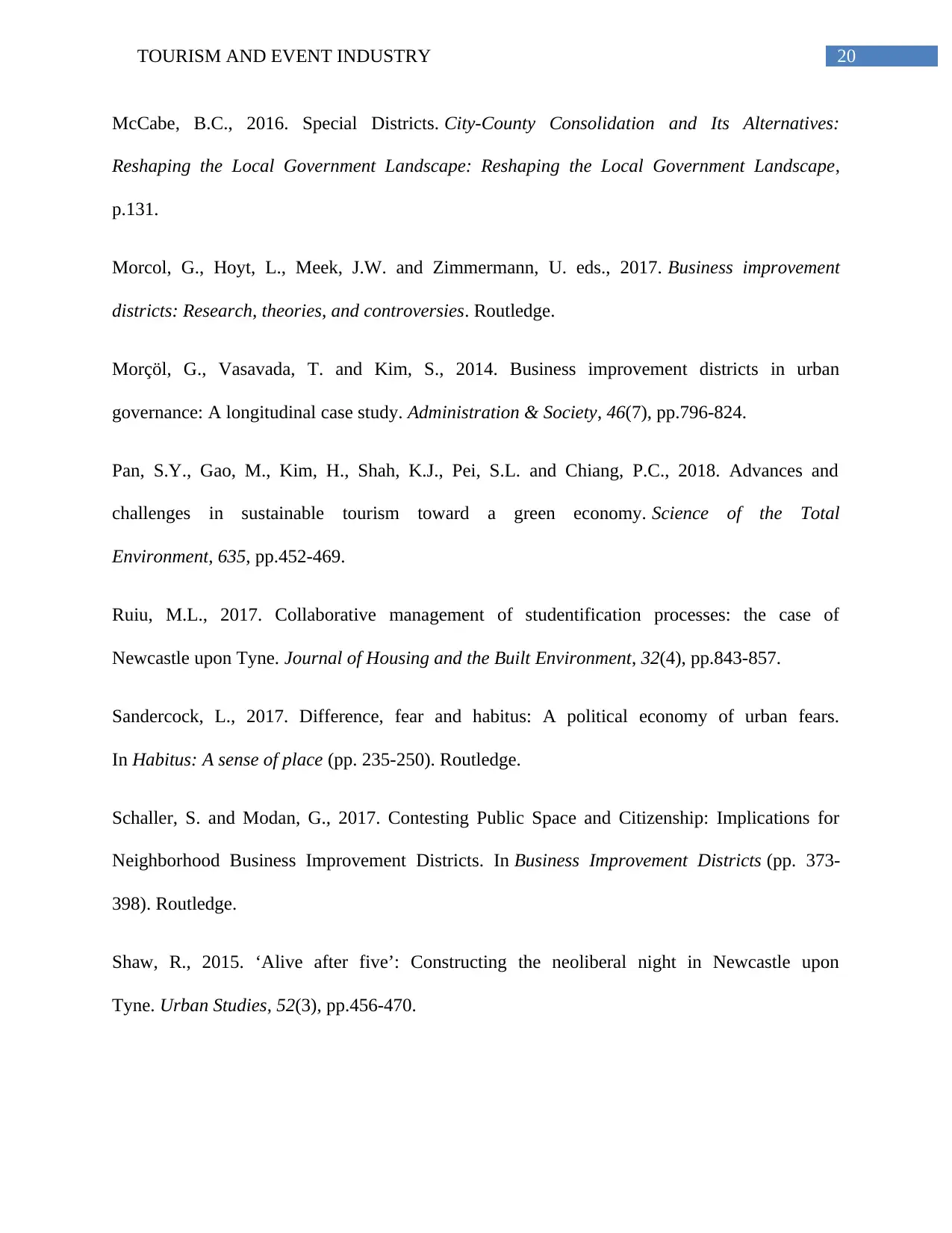
20TOURISM AND EVENT INDUSTRY
McCabe, B.C., 2016. Special Districts. City-County Consolidation and Its Alternatives:
Reshaping the Local Government Landscape: Reshaping the Local Government Landscape,
p.131.
Morcol, G., Hoyt, L., Meek, J.W. and Zimmermann, U. eds., 2017. Business improvement
districts: Research, theories, and controversies. Routledge.
Morçöl, G., Vasavada, T. and Kim, S., 2014. Business improvement districts in urban
governance: A longitudinal case study. Administration & Society, 46(7), pp.796-824.
Pan, S.Y., Gao, M., Kim, H., Shah, K.J., Pei, S.L. and Chiang, P.C., 2018. Advances and
challenges in sustainable tourism toward a green economy. Science of the Total
Environment, 635, pp.452-469.
Ruiu, M.L., 2017. Collaborative management of studentification processes: the case of
Newcastle upon Tyne. Journal of Housing and the Built Environment, 32(4), pp.843-857.
Sandercock, L., 2017. Difference, fear and habitus: A political economy of urban fears.
In Habitus: A sense of place (pp. 235-250). Routledge.
Schaller, S. and Modan, G., 2017. Contesting Public Space and Citizenship: Implications for
Neighborhood Business Improvement Districts. In Business Improvement Districts (pp. 373-
398). Routledge.
Shaw, R., 2015. ‘Alive after five’: Constructing the neoliberal night in Newcastle upon
Tyne. Urban Studies, 52(3), pp.456-470.
McCabe, B.C., 2016. Special Districts. City-County Consolidation and Its Alternatives:
Reshaping the Local Government Landscape: Reshaping the Local Government Landscape,
p.131.
Morcol, G., Hoyt, L., Meek, J.W. and Zimmermann, U. eds., 2017. Business improvement
districts: Research, theories, and controversies. Routledge.
Morçöl, G., Vasavada, T. and Kim, S., 2014. Business improvement districts in urban
governance: A longitudinal case study. Administration & Society, 46(7), pp.796-824.
Pan, S.Y., Gao, M., Kim, H., Shah, K.J., Pei, S.L. and Chiang, P.C., 2018. Advances and
challenges in sustainable tourism toward a green economy. Science of the Total
Environment, 635, pp.452-469.
Ruiu, M.L., 2017. Collaborative management of studentification processes: the case of
Newcastle upon Tyne. Journal of Housing and the Built Environment, 32(4), pp.843-857.
Sandercock, L., 2017. Difference, fear and habitus: A political economy of urban fears.
In Habitus: A sense of place (pp. 235-250). Routledge.
Schaller, S. and Modan, G., 2017. Contesting Public Space and Citizenship: Implications for
Neighborhood Business Improvement Districts. In Business Improvement Districts (pp. 373-
398). Routledge.
Shaw, R., 2015. ‘Alive after five’: Constructing the neoliberal night in Newcastle upon
Tyne. Urban Studies, 52(3), pp.456-470.
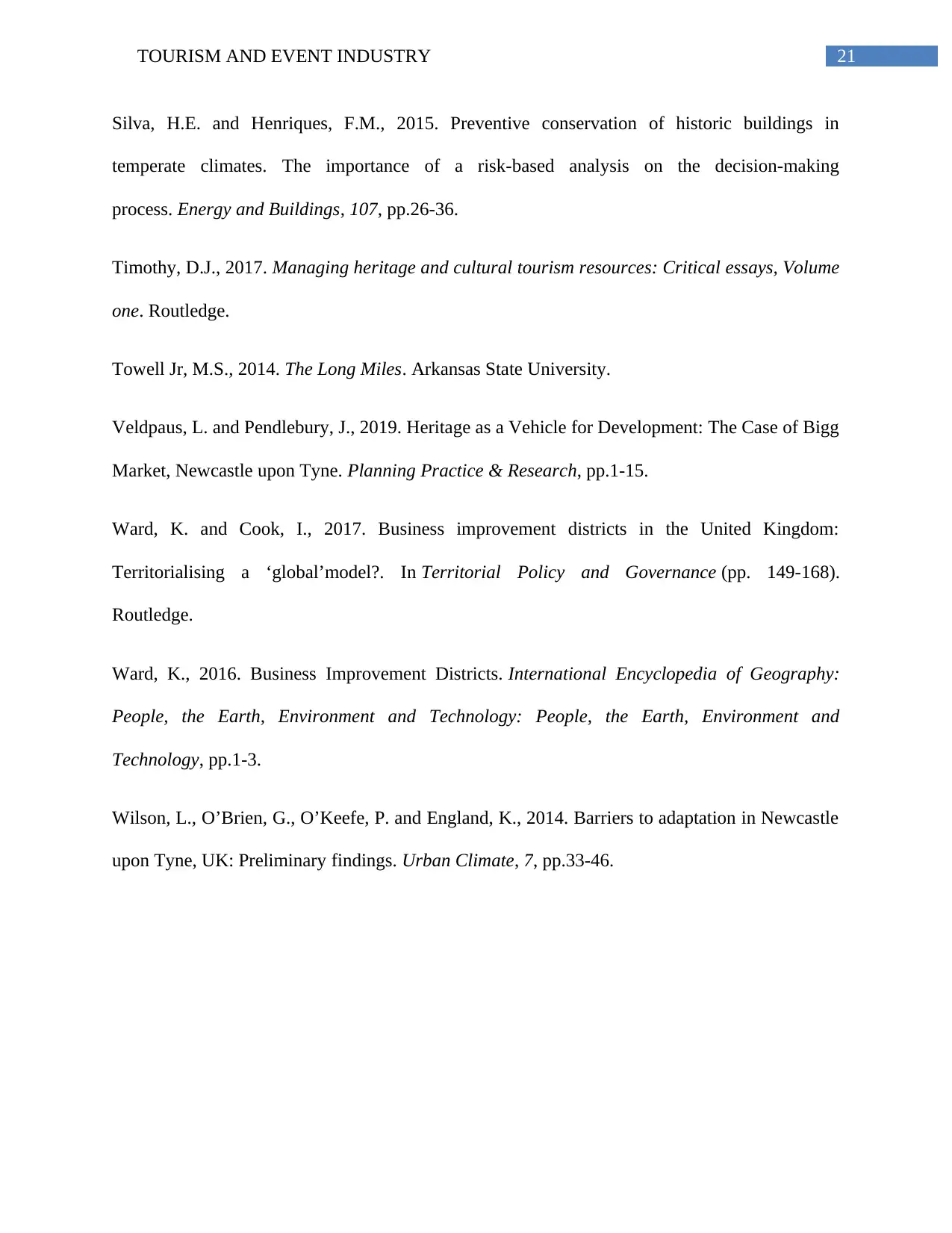
21TOURISM AND EVENT INDUSTRY
Silva, H.E. and Henriques, F.M., 2015. Preventive conservation of historic buildings in
temperate climates. The importance of a risk-based analysis on the decision-making
process. Energy and Buildings, 107, pp.26-36.
Timothy, D.J., 2017. Managing heritage and cultural tourism resources: Critical essays, Volume
one. Routledge.
Towell Jr, M.S., 2014. The Long Miles. Arkansas State University.
Veldpaus, L. and Pendlebury, J., 2019. Heritage as a Vehicle for Development: The Case of Bigg
Market, Newcastle upon Tyne. Planning Practice & Research, pp.1-15.
Ward, K. and Cook, I., 2017. Business improvement districts in the United Kingdom:
Territorialising a ‘global’model?. In Territorial Policy and Governance (pp. 149-168).
Routledge.
Ward, K., 2016. Business Improvement Districts. International Encyclopedia of Geography:
People, the Earth, Environment and Technology: People, the Earth, Environment and
Technology, pp.1-3.
Wilson, L., O’Brien, G., O’Keefe, P. and England, K., 2014. Barriers to adaptation in Newcastle
upon Tyne, UK: Preliminary findings. Urban Climate, 7, pp.33-46.
Silva, H.E. and Henriques, F.M., 2015. Preventive conservation of historic buildings in
temperate climates. The importance of a risk-based analysis on the decision-making
process. Energy and Buildings, 107, pp.26-36.
Timothy, D.J., 2017. Managing heritage and cultural tourism resources: Critical essays, Volume
one. Routledge.
Towell Jr, M.S., 2014. The Long Miles. Arkansas State University.
Veldpaus, L. and Pendlebury, J., 2019. Heritage as a Vehicle for Development: The Case of Bigg
Market, Newcastle upon Tyne. Planning Practice & Research, pp.1-15.
Ward, K. and Cook, I., 2017. Business improvement districts in the United Kingdom:
Territorialising a ‘global’model?. In Territorial Policy and Governance (pp. 149-168).
Routledge.
Ward, K., 2016. Business Improvement Districts. International Encyclopedia of Geography:
People, the Earth, Environment and Technology: People, the Earth, Environment and
Technology, pp.1-3.
Wilson, L., O’Brien, G., O’Keefe, P. and England, K., 2014. Barriers to adaptation in Newcastle
upon Tyne, UK: Preliminary findings. Urban Climate, 7, pp.33-46.
1 out of 22
Related Documents
Your All-in-One AI-Powered Toolkit for Academic Success.
+13062052269
info@desklib.com
Available 24*7 on WhatsApp / Email
![[object Object]](/_next/static/media/star-bottom.7253800d.svg)
Unlock your academic potential
© 2024 | Zucol Services PVT LTD | All rights reserved.





